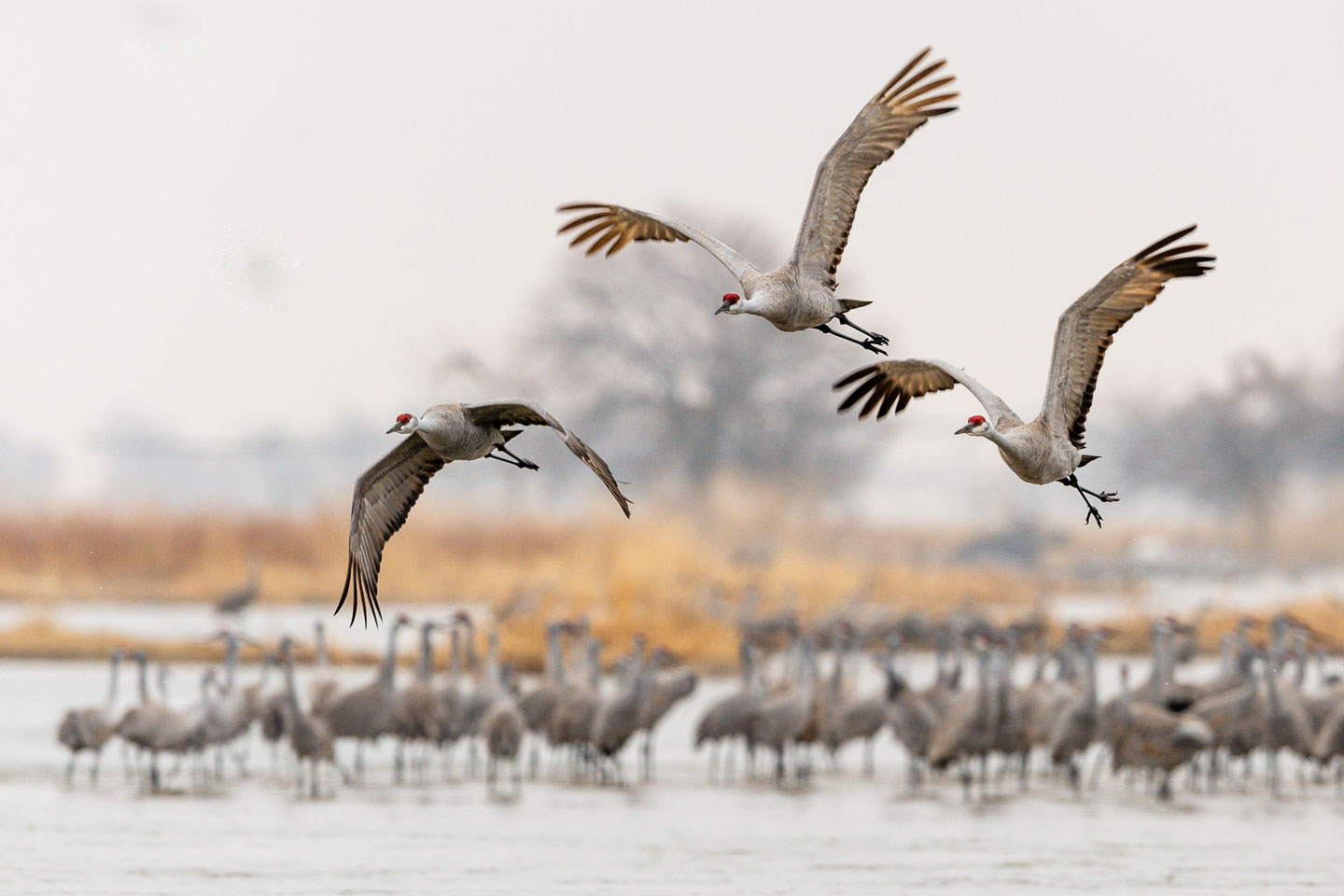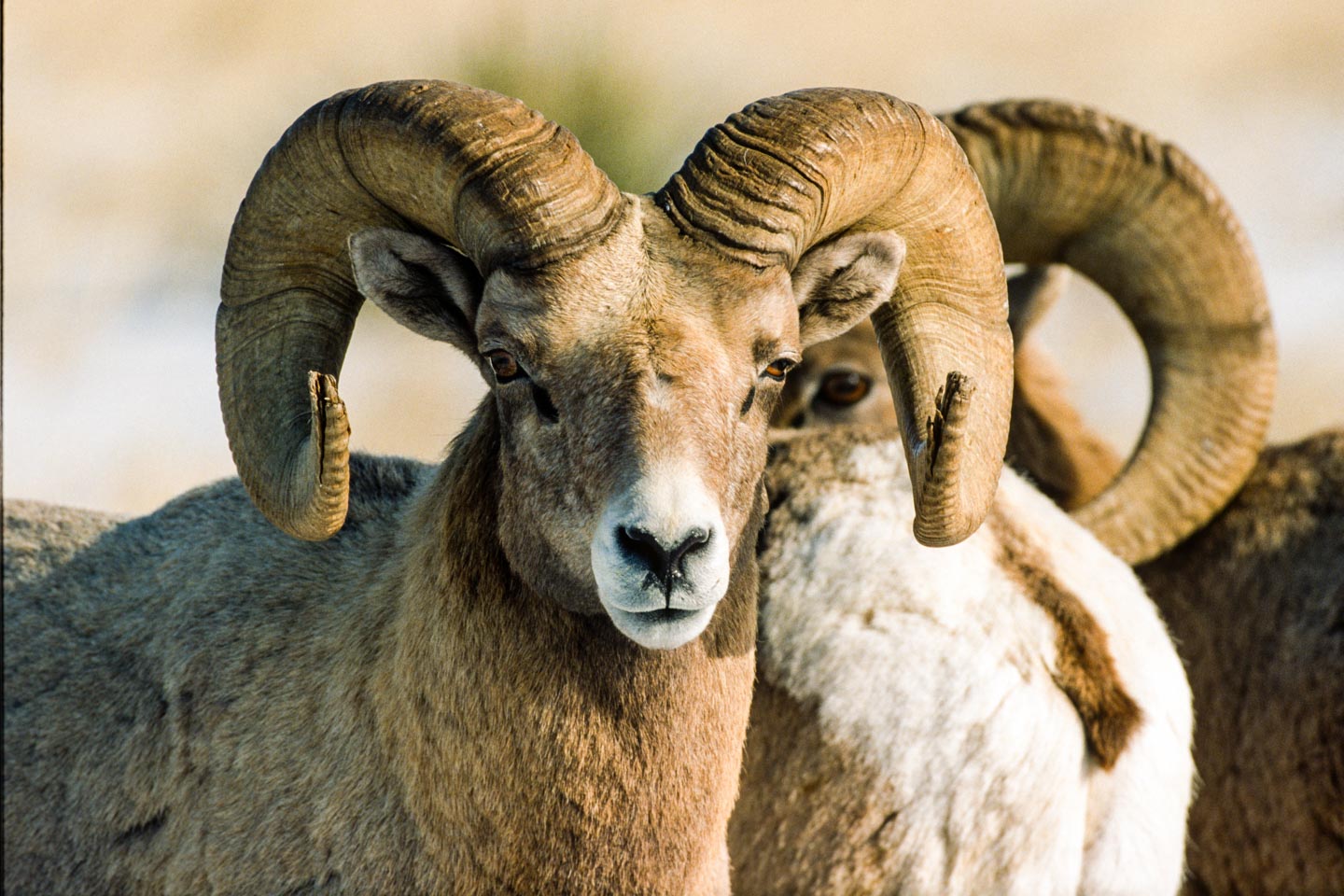Mammals
Nebraska is home to over 90 species of mammals, reflecting varied ecosystems from expansive prairies to wooded river valleys. These mammals not only play crucial roles in their respective habitats, but also offer unique insights into Nebraska’s ecoregions and evolutionary history. Conservation efforts provide vital sanctuaries, ensuring that Nebraska’s mammalian diversity continues to thrive amidst growing environmental challenges.
Mammal species in Nebraska
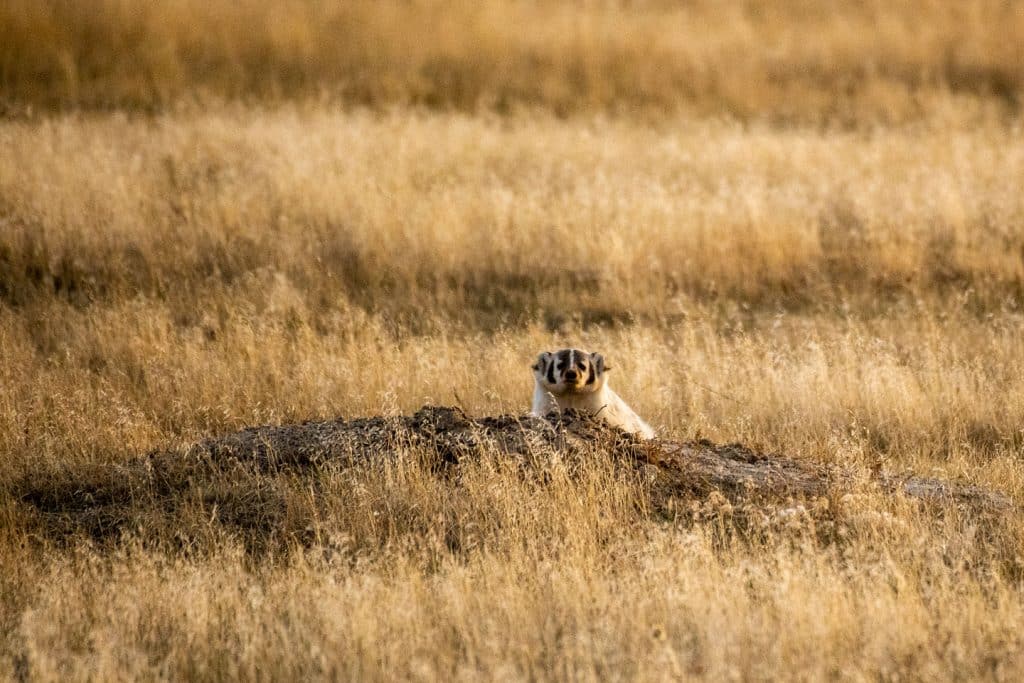
Physical description
The American badger is a sturdy, low-riding mammal characterized by its robust build and distinctive markings. It typically has short, coarse fur ranging in color from gray to brown, with a characteristic white stripe extending from its head down its back. Its head is broad with a flattened profile, adorned with small, rounded ears and sharp, powerful claws adapted for digging. Known for its ferocious disposition and amazing digging abilities, the American badger is an impressive predator in its habitat.
Habitat
In Nebraska, American badgers inhabit a variety of habitats, including grasslands, prairies, and agricultural fields. They prefer open areas with loose, sandy soils that are conducive to digging burrows, which serve as their primary shelter and breeding sites. Badgers are commonly found in regions with abundant rodent populations, as they rely heavily on small mammals such as ground squirrels, prairie dogs, and voles for food. Their habitat choice often overlaps with areas where their prey is plentiful, making grassland ecosystems across Nebraska prime territory for these skilled predators.
Diet
American badgers are carnivorous predators with a diet primarily consisting of small mammals such as ground squirrels, mice, voles, and pocket gophers. They are skilled diggers, using their powerful claws to excavate burrows and root out prey hidden underground. Badgers are opportunistic hunters and feed on birds, reptiles, amphibians, and insects when available. Their voracious appetite and hunting prowess make them top predators in their ecosystem, playing a crucial role in controlling rodent populations.
Population status & range
Common: found throughout the state, although more rare in the heavily wooded areas of the southeastern region
Behavior
American badgers are solitary and predominantly nocturnal creatures, although they may also be active during the day. Known for their tenacity and fierce demeanor, they are intense predators, relying on their keen sense of smell and powerful digging abilities to locate and capture prey. Badgers are skilled excavators, capable of digging elaborate burrow systems with multiple entrances where they rest, breed, and store food. They are territorial animals, marking their territories with scent glands and defending them aggressively against intruders. Despite their solitary nature, they may tolerate the presence of other badgers during the breeding season.
Fun facts
>> Have been known to hunt alongside coyotes. The badger will take advantage of prey driven underground by the coyote. The coyote will then benefit from burrowing prey being chased above ground by the badger.
>> Although not a true hibernator, the American Badger is known to sleep for a few days, or weeks in the dead of winter.
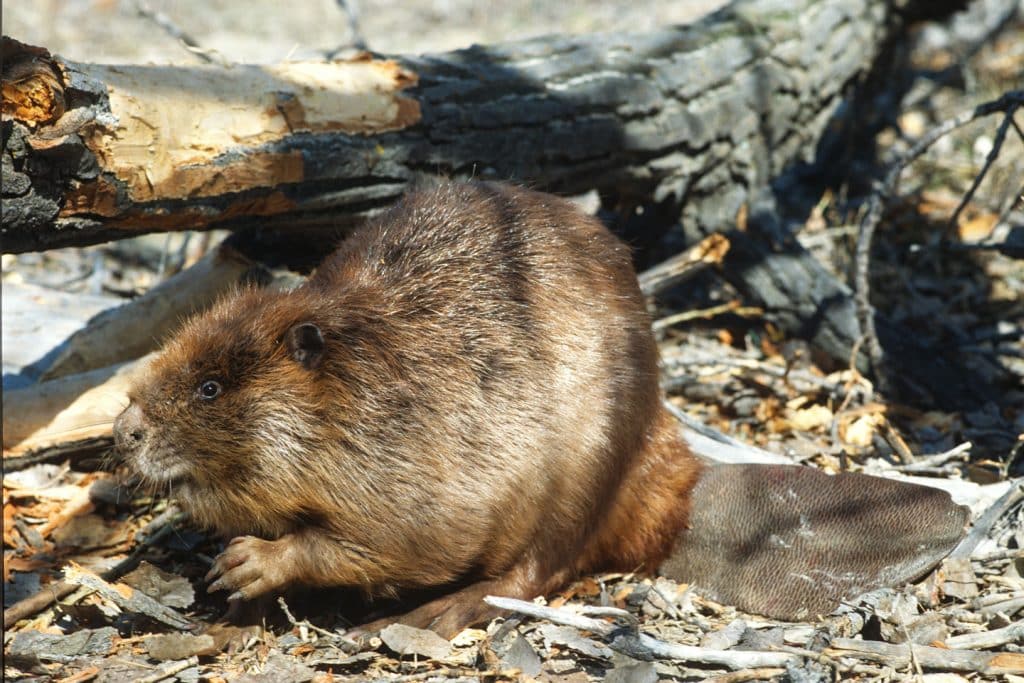
Physical description
The American beaver is a large semi-aquatic rodent with a robust, barrel-shaped body covered in dense, waterproof fur. Its fur varies in color from dark brown to reddish-brown, helping it blend into its surroundings. Beavers possess webbed hind feet and a broad, flat tail, which they use as a rudder while swimming and as a tool for constructing dams and lodges. Their large, orange incisors are well-known for their ability to gnaw through wood with ease, essential for their habitat modification activities.
Habitat
In Nebraska, American beavers are commonly found in lands along rivers, streams, and lakes, known as riparian habitat. These aquatic ecosystems support their dam-building activities. They prefer areas with a mix of open water and adjacent woodlands, providing ample food and building materials. Beavers construct lodges or burrows along the water’s edge, using branches, mud, and vegetation to create sheltered living spaces. Their habitat modifications play a crucial role in wetland conservation and ecosystem health by creating habitats for numerous other species.
Diet
American beavers are herbivorous rodents with a diet primarily consisting of bark, twigs, and leaves from a variety of tree species such as aspen, willow, and cottonwood. They are particularly fond of the cambium layer found just beneath the bark, which is rich in nutrients. Beavers also consume aquatic plants, grasses, and roots, supplementing their diet with aquatic vegetation found in their riparian habitats. Their strong incisors enable them to gnaw through tough woody material, essential for both feeding and constructing their dams and lodges.
Population status & range
Common: can be found throughout the state where there is water
Behavior
American beavers are renowned for their industrious and engineering skills. They are expert builders, constructing dams across streams and rivers using branches, mud, and stones to create deep ponds that provide protection from predators and access to food. Beavers are primarily nocturnal, working at night to maintain and expand their habitats. They are highly social animals, living in family groups consisting of a mated pair and their offspring. Communication among beavers involves vocalizations, tail slapping on the water, and scent marking. Their extensive dam-building activities not only alter the landscape but also create vital habitats for a variety of other species.
Fun facts
>> Beavers are the largest rodents in North America, and second largest rodents in the world.
>> During winter, beavers accumulate excess fat reserves in their tails, which they utilize as a source of energy. As they draw upon these fat stores, their tails gradually shrink in size.
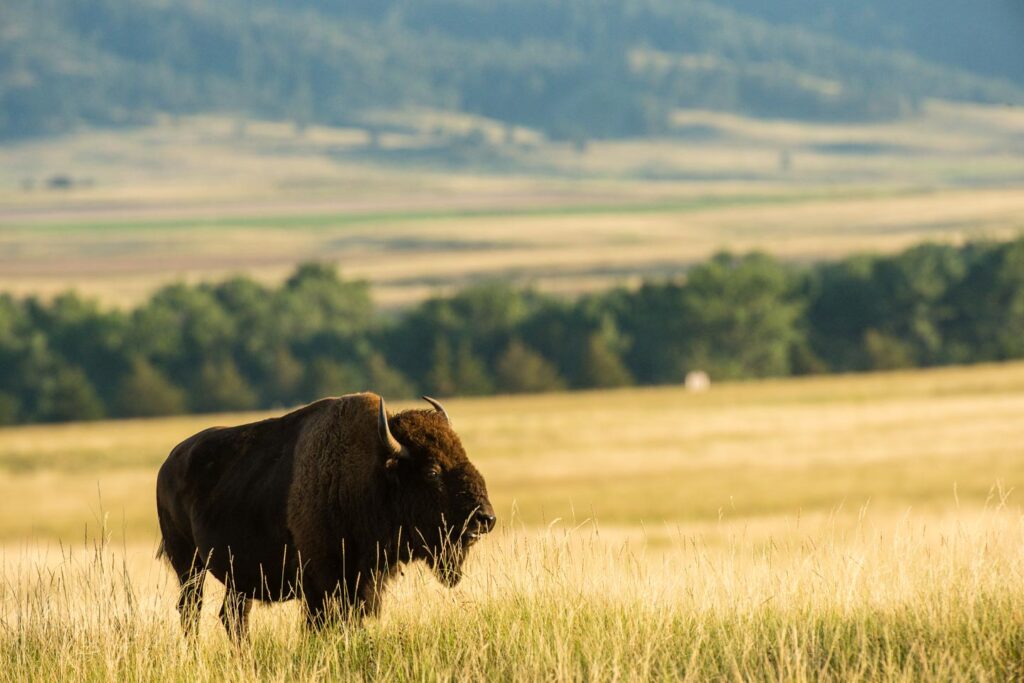
Physical description
The American bison is one of the largest and most recognizable mammals in Nebraska. They have a massive head topped with short, curved horns, and a shaggy mane of dark brown fur around their neck and shoulders. Bison bodies are covered with a thick coat that varies from dark brown to black, which helps them withstand harsh weather. Their forequarters are more muscular and elevated than their hindquarters, giving them a sloping back. Adult males, known as bulls, can weigh up to 2,000 pounds. Females, or cows, are smaller, typically weighing around 1,000 pounds.
Habitat
In Nebraska, American bison primarily inhabit prairies and grasslands, which provide the wide-open spaces necessary for grazing. These vast, flat regions offer an abundance of native grasses for grazing. Historically, bison roamed freely across Nebraska’s plains, but today, they are mostly found in protected areas such as national and state parks, wildlife reserves, and private ranches dedicated to conservation efforts. These areas mimic their natural habitat, ensuring they have the necessary resources for feeding, breeding, and migrating.
Diet
The American bison is primarily a grazer, feeding mainly on grasses found in prairies and plains. Their diet includes a variety of grasses, such as buffalo grass, bluestem, and wheatgrass, which they consume in large quantities. Bison also eat sedges, forbs, and, occasionally, the leaves and bark of shrubs and trees. Their efficient digestive system allows them to extract nutrients from coarse and fibrous plant materials, enabling them to survive in diverse grassland ecosystems. During winter, bison use their strong heads and shoulders to clear snow and access the vegetation beneath.
Population status & range
Extirpated (species no longer exists in the wild): there are captive bison herds in Nebraska, along with several ranched herds throughout the state, including the Sandhills.
Behavior
The American bison exhibits a range of behaviors that reflect its social and adaptive nature. These animals are highly sociable, often forming large herds, particularly during the breeding season. Within these herds, they establish a social hierarchy through displays of dominance such as head butting and charging. Bison are migratory, moving in response to seasonal changes to find food and water. They communicate using a variety of vocalizations, including grunts and snorts, and use body language to convey different messages. Despite their large size, bison can run at speeds up to 35 miles per hour and are capable swimmers, which helps them evade predators and navigate their environment.
Fun facts
>> Both male and female bison grow horns. A cow’s horns will be more C-shaped and slender compared to a bull.
>> Often referred to as “red dogs”, bison calves are born with a reddish hide. As they get older, their hide becomes a deep brown color.

Physical description
The American mink is a cat-sized member of the Mustelidae (weasel) family with a long, slender body adapted for its semi-aquatic lifestyle. It has dense fur that is typically dark brown to black in color, with a glossy appearance. Minks have a slightly flattened head with small, rounded ears and a pointed snout. Their legs are relatively short, but they are strong swimmers, propelled by their webbed feet and muscular tail. Minks have sharp claws and powerful jaws, which they use for catching prey.
Habitat
American minks are semi-aquatic mammals that inhabit a variety of habitats across North America, including wetlands, marshes, rivers, streams, lakeshores, and coastal areas. They prefer habitats with dense vegetation and abundant cover, providing opportunities for hunting and shelter. Minks are particularly associated with riparian habitats, where they can access freshwater sources and find prey such as fish, amphibians, and crustaceans. Additionally, they may utilize upland areas with suitable denning sites, such as burrows in riverbanks, hollow logs, or abandoned dens of other animals.
Diet
The American mink is a carnivorous mammal with a varied diet that includes fish, amphibians, small mammals, birds, and invertebrates such as crayfish and insects. They are opportunistic hunters and are known to prey on muskrats, rabbits, and waterfowl. Minks often hunt along the water’s edge, utilizing their excellent swimming abilities to catch aquatic prey. Additionally, they may scavenge carrion when available.
Population status & range
Common, found statewide
Behavior
The American mink is a semi-aquatic mammal known for its solitary and territorial behavior. It is an adept swimmer, often found near water bodies like rivers, streams, and lakes. Minks are primarily nocturnal, hunting for prey such as fish, small mammals, and birds during the night. They are also known for their curious and aggressive nature, especially when defending their territory. In the wild, they exhibit a range of vocalizations and scent markings to communicate with other minks and to establish their presence in a particular area.
Fun facts
>> Need a permanent water source to thrive. They will make their dens in the banks of rivers or in previously abandoned mammal burrows.
>> American Mink have few natural predators but can be predated on by coyotes, bobcats, and other large carnivores.
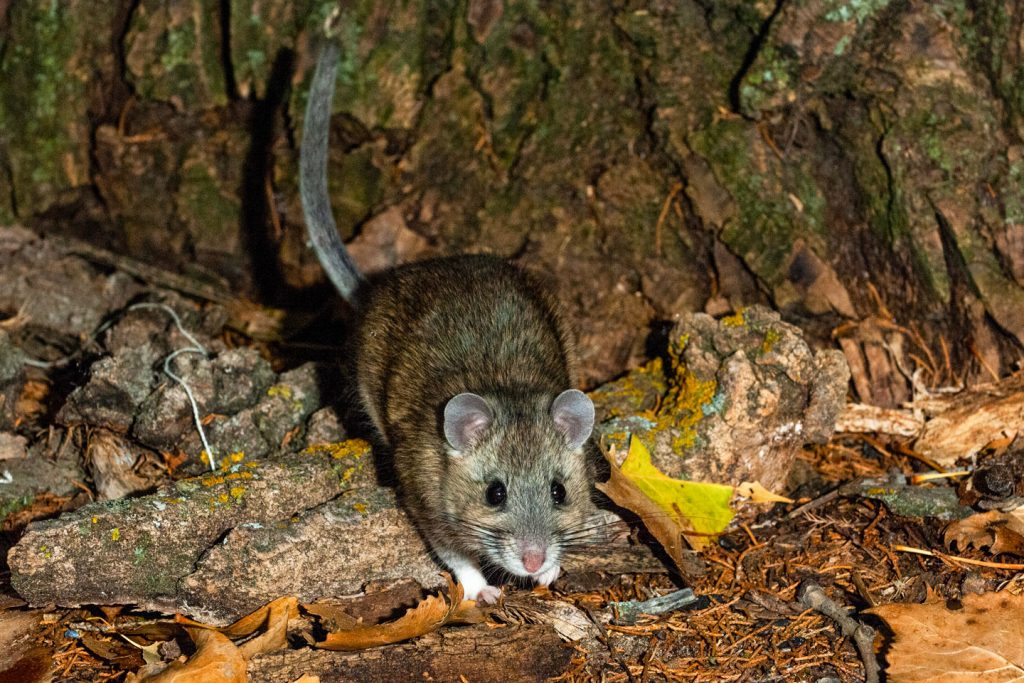
Physical description
Bailey’s eastern woodrat is a medium-sized rodent with a stout body and a relatively short tail. Its fur varies in color from grayish to reddish brown, with a lighter underside. This woodrat has large, rounded ears and prominent dark eyes. One of its distinctive features is its long, whiskered face with prominent incisors. These rodents have thick hind legs and strong claws adapted for climbing and navigating their habitat.
Habitat
The Bailey’s eastern woodrat can be found in a few various habitats. It mainly resides within or along the edge of woodlands, and does not prefer grasslands.
Diet
Bailey’s eastern woodrats are primarily herbivorous, feeding on a variety of plant material. Their diet includes seeds, nuts, fruits, leaves and twigs gathered from their forested habitat. Additionally, they may consume bark and gnaw on woody vegetation for both nutritional and territorial purposes. Occasionally, Bailey’s woodrats may supplement their diet with insects or other small invertebrates.
Population status & range
Tier 1: endemic species found nowhere else in the world besides Nebraska; an isolated population resides along the central Niobrara River
Behavior
The breeding season of eastern woodrats varies geographically and it is uncertain how many months through the year the Bailey’s eastern woodrat breeds in Nebraska. These typically solitary animals will build a large house for protection against predators and natural elements. The woodrat will often use rocks or the base of woody plants for supporting structure for its shelter. Woodrats primarily use twigs and leaves as construction materials but numerous other natural and man-made items are used as well.
Fun facts
>> These woodrats are sometimes referred to as a pack rat, or trade rat.
>> Woodrats exhibit aggressive behavior in defending territories where they frequently injure or even kill another.
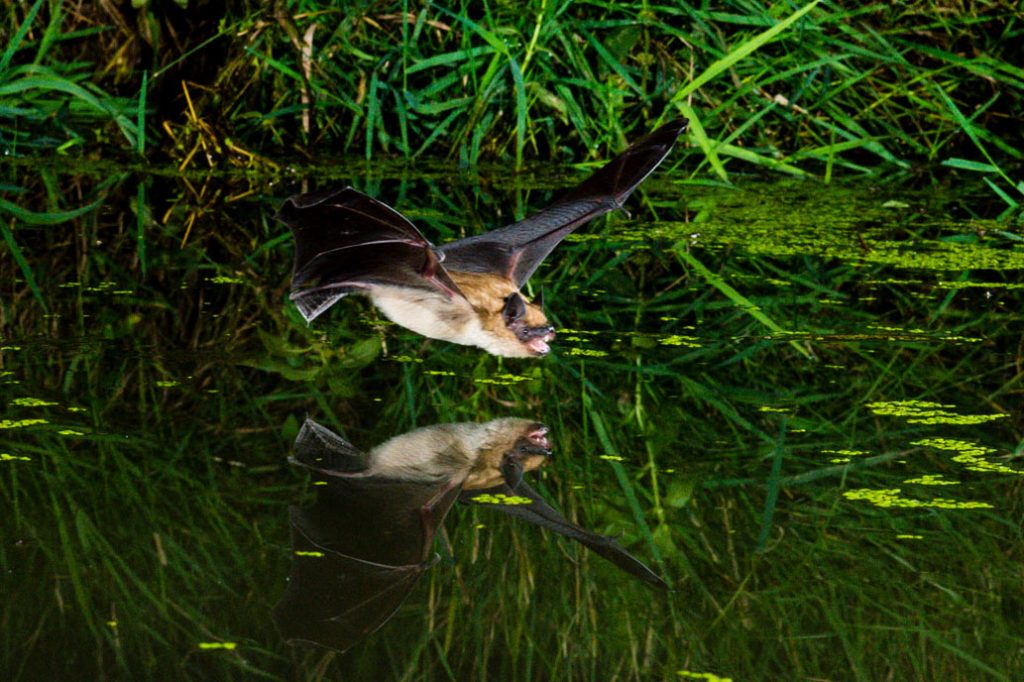
Physical description
The big brown bat is a medium-sized bat species with a robust, sturdy build. It typically has brown fur that ranges from dark brown to reddish-brown, hence its name. Its wingspan can reach up to 13 inches (33 centimeters), and its wings are broad and dark in color. Big brown bats have large, hairless ears with a distinct tragus, which helps them in echolocation. They also have a short snout with a broad, rounded nose, and their eyes are relatively small.
Habitat
Big brown bats in Nebraska inhabit a variety of habitats, including forests, woodlands, riparian areas, and urban environments. They are adaptable creatures and can be found roosting in a diverse range of structures such as caves, rock crevices, buildings, barns, and tree hollows. During the summer months, they often roost in maternity colonies where females give birth and raise their young. Additionally, big brown bats require access to water sources for drinking and foraging, making areas near rivers, streams, and ponds attractive habitats for them.
Diet
The diet of a big brown bat primarily consists of insects, making them insectivorous predators. They prey on a wide variety of flying insects, including beetles, moths, mosquitoes, and flies, which they catch in mid-air using echolocation. Big brown bats are particularly adept at hunting over open areas such as fields, forests, and bodies of water where insects are abundant. They consume large quantities of insects each night, playing a crucial role in controlling insect populations and maintaining ecosystem balance.
Population status & range
Common: found statewide
Behavior
Big brown bats are nocturnal creatures, meaning they are most active during the night. They are agile fliers, capable of maneuvering swiftly and gracefully through the air as they hunt for insects. Using echolocation, they emit high-frequency sounds that bounce off objects and prey, allowing them to navigate and locate food in the darkness. Big brown bats often roost in colonies during the summer months, where females give birth and raise their young. During the winter, they hibernate in sheltered locations such as caves, mines, or buildings to conserve energy when insect prey is scarce.
Fun facts
>> Using echolocation bats can determine how far away an object is, the object’s size, shape, and density, and the direction (if any) that an object is moving.
>> Baby bats are known as pups. They begin flying at 3-5 weeks in age and become independent a few weeks later.
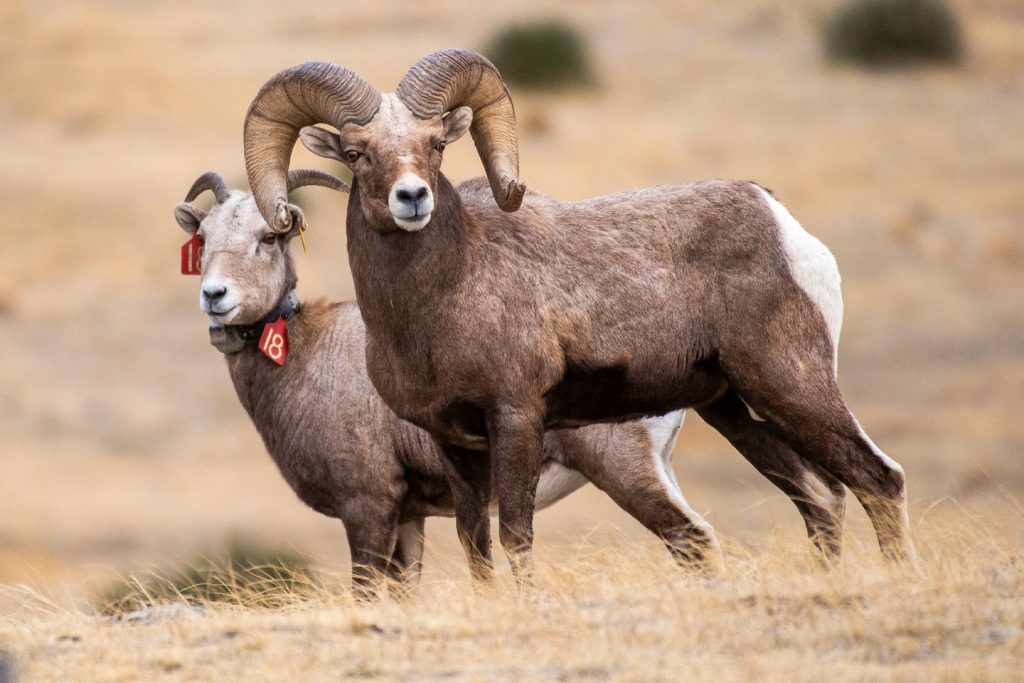
Physical description
Bighorn sheep are hefty and muscular animals, easily recognizable by their large, curved horns. Males, known as rams, possess massive, spiraled horns that can weigh up to 30 pounds and serve as symbols of their strength and dominance. Females, or ewes, have smaller, slightly curved horns. Bighorn sheep have a short, stocky body covered in a coat of brown to grayish-brown fur, with a white rump patch and white lining on the back of their legs. They have sharp, black hooves adapted for climbing and navigating rocky terrains. Adult bighorn sheep typically stand about 3 feet tall at the shoulder and can weigh between 100 to 300 pounds, with rams being larger and heavier than ewes.
Habitat
In Nebraska, bighorn sheep inhabit rugged, rocky terrains in the northwest region. They prefer areas with steep cliffs and canyons, which provide excellent vantage points and escape routes from predators. These environments also offer a mix of grasses, shrubs and forbs that make up their diet. Bighorn sheep are well-adapted to the semi-arid conditions of Nebraska’s Pine Ridge and bluffs, where they find shelter and breeding grounds. Conservation areas and wildlife reserves in Nebraska help protect these natural habitats, ensuring that bighorn sheep populations can thrive.
Diet
In Nebraska, bighorn sheep primarily graze on a diet that includes a variety of grasses, such as bluegrass and wheatgrass, which provide essential nutrients. They also consume forbs, shrubs, and browse on vegetation like sagebrush and rabbitbrush, which are abundant in their rocky and semi-arid habitats. During different seasons, they adjust their diet based on availability, often grazing on green grasses in the spring and summer and shifting to shrubs and dried grasses in the fall and winter. This varied diet helps them to maintain their health and energy throughout the year, despite the challenging terrain and climate.
Population status & range
Extirpated (species no longer exists in the wild): In 1981, the Nebraska Game and Parks Commission began a project to return bighorn sheep to some of its native ranges in Nebraska. Fort Robinson State Park was the site of the initial release of a dozen individuals, and subsequent releases of bighorns in 1988, 2001, 2005, 2007 and 2012 have established bighorns in the Wildcat Hills and Pine Ridge of Nebraska’s panhandle.
Behavior
Bighorn sheep exhibit behavior that is both social and territorial. They live in groups, with males (rams) forming separate bachelor herds and females (ewes) living with their young. During the mating season, rams compete for dominance through dramatic head-butting battles, which can involve charging at each other at high speeds. These contests establish a hierarchy that determines access to mating opportunities. Bighorn sheep are also adept climbers, using their agility to navigate steep, rocky terrains to find food and evade predators. They communicate through a variety of vocalizations and body postures, maintaining social bonds and coordination within their groups.
Fun facts
>> Bighorn sheep have horns that represent their age and rank. Male horns can weigh up to 30 pounds and are a status symbol. The number of horn segments counted in the fall is one more than the ram’s age. Females have shorter horns that are less curved.
>> Bighorn sheep have hooves that are hard around the outside and soft on the inside, which help give them traction on slippery rocks.
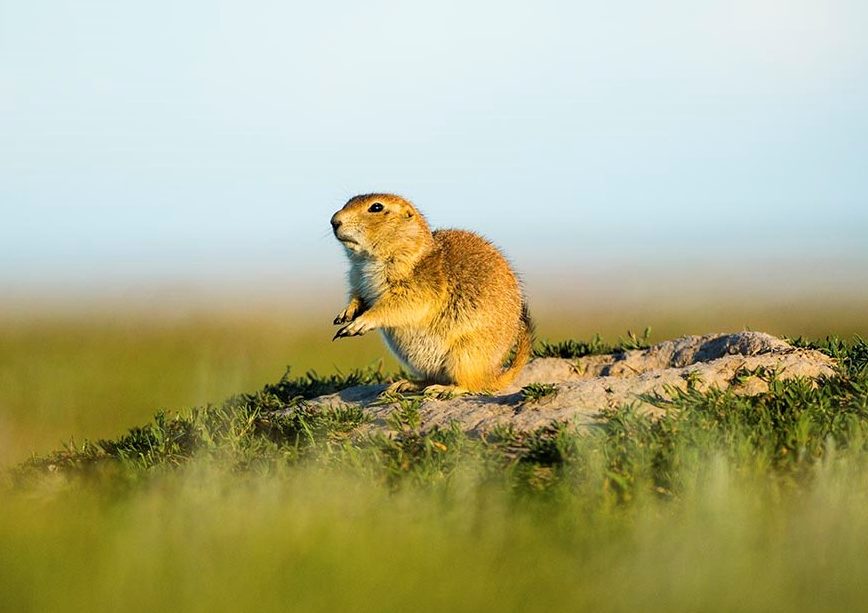
Physical description
The black-tailed prairie dog is a small rodent, measuring about 14 to 17 inches in length and weighing between 1.5 to 3 pounds. It has tan to light brown fur and a distinctive, black-tipped tail. Its head is broad with large, dark eyes and small, rounded ears. Adapted for digging, the prairie dog has strong limbs with long, sharp claws.
Habitat
Black-tailed prairie dogs inhabit the grasslands and prairies of North America, primarily in the central and western United States. They prefer open, flat areas with short grasses, which provide both food and visibility to spot predators. These social rodents live in extensive underground burrow systems known as “towns,” which can cover large areas and support big colonies. Their burrows have multiple entrances and chambers, offering shelter and protection from extreme weather and predators.
Diet
Black-tailed prairie dogs primarily feed on grasses and herbaceous plants, which make up the bulk of their diet. They consume a variety of vegetation, including seeds, roots and leaves. They may eat insects occasionally, but plant material remains their main food source. Their foraging habits help maintain the health of their grassland ecosystems by promoting plant diversity and soil aeration.
Population status & range
Common in the western 3/4 of Nebraska
Behavior
Black-tailed prairie dogs are highly social animals, living in large “town” colonies. They exhibit complex behaviors, including vocal communication with a variety of calls to alert others of predators. These prairie dogs are diurnal, being most active during the day. They engage in mutual grooming and cooperative care of young, which strengthens social bonds within the colony. Their alertness and communal nature helps them effectively monitor for threats and maintain their burrow systems.
Fun facts
>> Prairie dogs are recognized as keystone species, meaning other animals depend on them. Removing these animals would cause extensive changes to ecosystem functions.
>> During the 20th century, about 98% of all prairie dogs were exterminated. Their range today has shrunk to be about 5% of it’s historic spread.
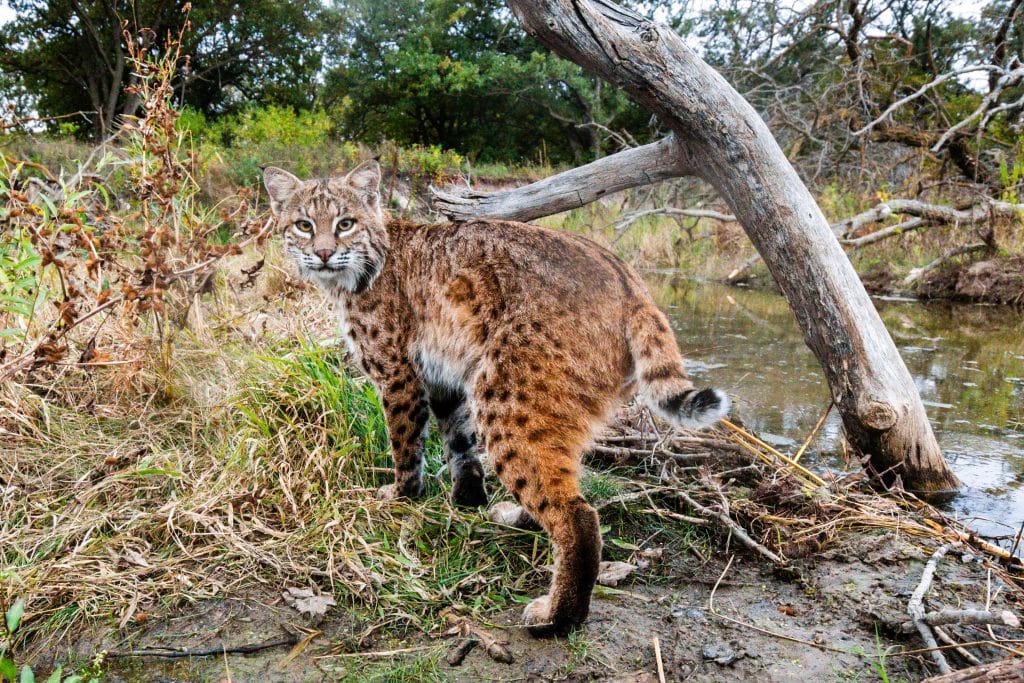
Physical description
Bobcats are medium-sized wildcats with a distinctive appearance. They have short, tawny fur with prominent black spots and stripes, providing excellent camouflage in their wooded habitats. Their fur may vary in color, ranging from grayish-brown to reddish-brown. Bobcats have tufted ears with distinctive black tufts, giving them their name, and their faces feature whiskered cheeks and a short, stubby tail. They have muscular, compact bodies with powerful limbs, enabling them to navigate through dense vegetation and make agile leaps while hunting.
Habitat
In Nebraska, bobcats inhabit a variety of habitats, including forests, woodlands, grasslands, and brushy areas. They are versatile creatures capable of adapting to a range of environments, from rugged canyons to agricultural lands. Bobcats prefer habitats with ample cover for stalking prey, such as dense vegetation or rocky outcrops, and they are often found near water sources like rivers or streams. They may also utilize urban and suburban areas with suitable habitat features. These adaptable predators thrive in landscapes that offer a mix of prey species and suitable denning sites.
Diet
Bobcats are carnivorous predators with a diverse diet. They primarily hunt small to medium-sized mammals such as rabbits, squirrels, mice, and voles. Additionally, they may prey on birds, reptiles, and insects when available. Bobcats are opportunistic hunters, stalking their prey using stealth and ambush tactics. Their diet may also include larger mammals like deer or livestock in certain circumstances. These adaptable predators play a crucial role in controlling prey populations and maintaining ecosystem balance in their habitats.
Population status & range
Common: widely distributed across Nebraska
Behavior
Bobcats are solitary and elusive creatures, typically avoiding human contact and preferring to hunt and roam alone. They are crepuscular hunters, meaning they are most active during dawn and dusk, utilizing their keen senses to stalk prey with stealth and precision. Bobcats are territorial animals, marking their ranges with scent markings and scratches to communicate with other individuals. They are skilled climbers and swimmers, capable of navigating through various terrains to pursue prey or find suitable denning sites. Although normally solitary they may interact with other bobcats during the breeding season.
Fun facts
>> Can leap as far as 12 feet to catch prey and have been known to take down animals much larger than themselves, like young deer.
>> Often confused with the Canadian Lynx, which are not present in Nebraska.
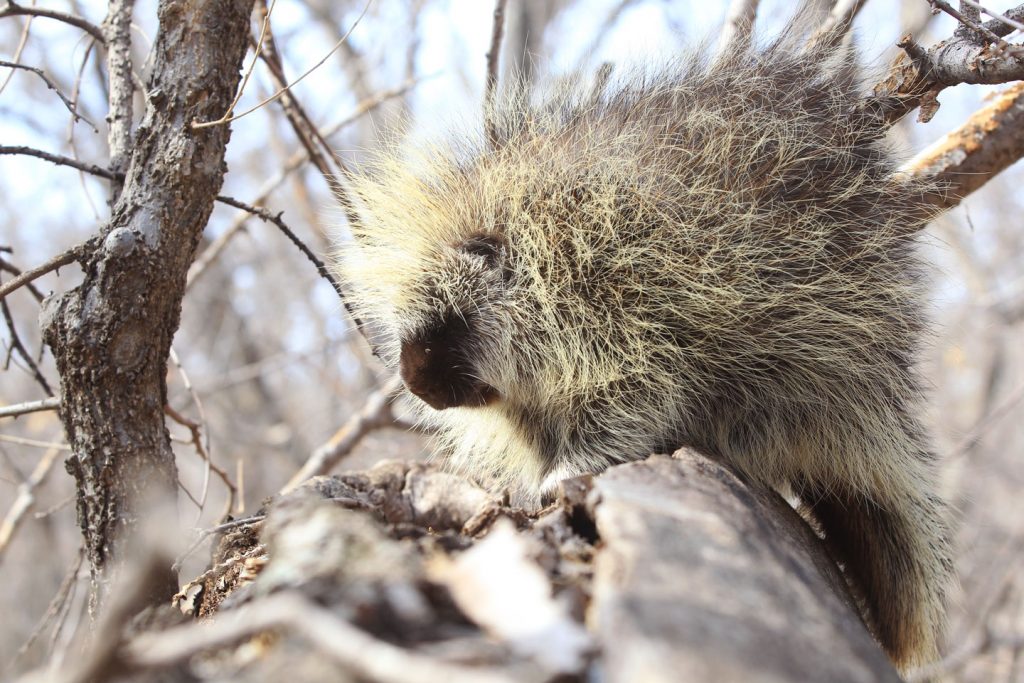
Physical description
The common porcupine is a large rodent weighing around 20 pounds. It has a body covered in sharp, barbed quills, which are modified hairs made of keratin. These quills vary in color from yellowish to brownish or black, with lighter tips. The quills are interspersed with softer fur on the porcupine’s face, belly and underside. Porcupines have a small head with a blunt snout and large, round eyes. They have short legs with strong claws adapted for climbing and foraging.
Habitat
In Nebraska, common porcupines primarily inhabit forested areas, particularly those with dense stands of coniferous trees such as pine, cedar and spruce. They are commonly found in mixed forests, as well, where deciduous trees are interspersed with conifers. Porcupines are also known to inhabit wooded areas along streams and rivers. These rodents are great climbers and often den in trees or rocky outcrops, using their strong claws and prehensile tails to navigate their wooded habitat. While porcupines are not as common in Nebraska compared to some other states, they can still be found in suitable forested habitats throughout the state.
Diet
Porcupines are primarily herbivores, feeding on a variety of plant materials. Their diet consists mainly of leaves, twigs, bark and buds from a wide range of trees and shrubs. They prefer the tender inner bark of trees during winter when other food sources may be scarce. Porcupines are known to consume the bark and branches of both deciduous and coniferous trees. They may also feed on herbaceous plants and grasses when available. Despite their herbivorous diet, porcupines have been observed occasionally gnawing on bones, antlers and other materials for calcium and minerals.
Population status & range
Statewide; more common in the western 1/3 of Nebraska
Behavior
Common porcupines are primarily nocturnal creatures, spending much of their time foraging for food during the night. They are solitary animals, typically only coming together to mate. Porcupines are excellent climbers and spend a significant amount of time in trees, where they seek shelter and food. When threatened, they raise and rattle their quills as a warning display. If cornered, they may lash out with their quill-covered tails or attempt to climb higher into the safety of trees. Despite their solitary nature, porcupines are not aggressive and will generally try to avoid confrontations with other animals.
Fun facts
>> Porcupines are excellent swimmers because their hollow quills help keep them afloat.
>> Baby porcupines are called porcupettes and stay with their mom for about 6 months after birth.
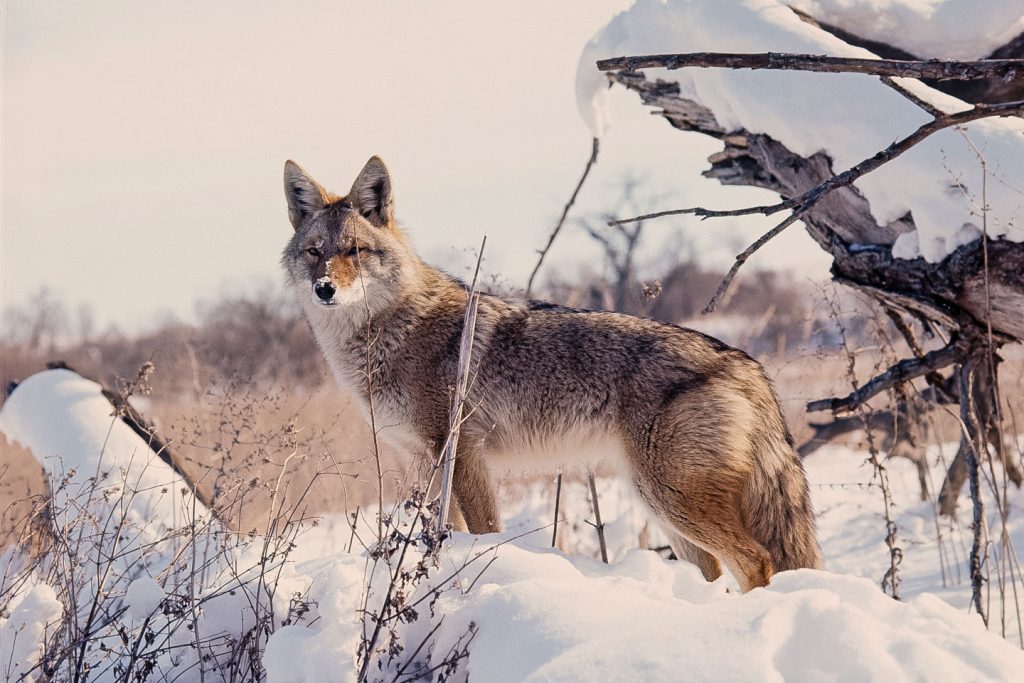
Physical description
Coyotes are medium-sized canines (dogs) with a lean, agile build. They typically have a gray or reddish-brown coat, sometimes with patches of white or black. Their bushy tail is usually tipped with black. Coyotes have pointed ears and a narrow muzzle, giving them a distinct appearance. They are smaller than wolves but larger than foxes.
Habitat
Coyotes are highly adaptable animals that inhabit a wide range of habitats throughout North America, from deserts and grasslands to forests and urban areas. They prefer areas with a mix of open spaces for hunting and dense vegetation for cover and denning sites. Coyotes are often found near water sources such as rivers, streams, and lakes, as these areas attract prey species. Their ability to thrive in diverse environments makes them one of the most widespread and successful carnivores on the continent.
Diet
Coyotes are opportunistic omnivores with a varied diet. They primarily prey on small mammals such as rabbits, rodents, and squirrels, but they also consume birds, insects, reptiles, and amphibians. Additionally, coyotes scavenge for carrion and feed on fruits, berries, and other vegetation.
Population status & range
Common: found statewide
Behavior
Coyotes are highly adaptable and intelligent predators, known for their cunning behavior. They are primarily nocturnal and crepuscular, hunting and foraging during the night and at dawn or dusk. Coyotes are solitary hunters but may form pairs or small family groups during the breeding season. They are skilled hunters, using stealth, teamwork, and their keen senses to stalk and ambush prey. Coyotes are also opportunistic scavengers, feeding on carrion and exploiting human food sources when available.
Fun facts
>> Researchers have identified 11 different vocalizations from coyotes, this includes growls, huffs, woofs, barks, and yips to name a few.
>> Pups normally stay with the parents for the first six to nine months of their life.
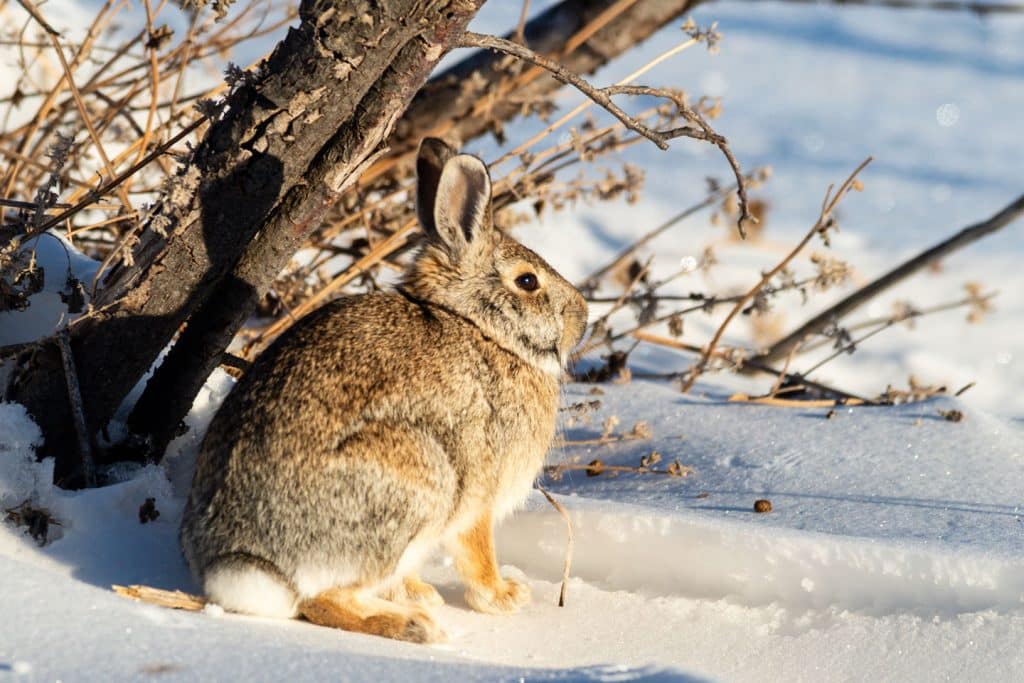
Physical description
The Eastern cottontail rabbit is a medium-sized mammal with soft, dense fur ranging in color from brown to gray, often with a reddish tint on its back. It has a distinctive white underside and a fluffy white tail resembling a cotton ball, from which it derives its name. Cottontail rabbits have large ears and large, dark eyes, aiding in their keen sense of hearing and vision, essential for detecting predators in their habitat. They have slender, agile bodies, adapted for swift movements and evasive maneuvers in response to threats.
Habitat
Eastern cottontail rabbits inhabit a variety of habitats, including fields, meadows, brushy areas, and woodland edges across much of North America. They prefer habitats with dense vegetation providing cover from predators and ample food sources like grasses, herbs, and shrubs. Cottontails are adaptable creatures and can also be found in urban and suburban environments with suitable cover and forage. Their habitats typically include a mix of open areas for feeding and dense vegetation for shelter, allowing them to thrive in diverse landscapes.
Diet
The Eastern cottontail rabbit is primarily herbivorous, with a diet consisting mainly of grasses, clover, and other green vegetation. They also consume a variety of herbs, flowers, and agricultural crops when available. Cottontails are selective feeders, preferring tender young shoots and leaves, but they will also eat bark and twigs in winter when other food sources are scarce. Their diet is high in fiber, essential for their digestive health, and they obtain most of their water from the moisture content of their food.
Population status & range
Common: found statewide
Behavior
Eastern cottontail rabbits are crepuscular animals, most active during dawn and dusk, though they may also be active during the night in areas with less human disturbance. They are generally solitary creatures, except during the breeding season, and use a system of scent markings to communicate with each other. Cottontails are cautious and skittish animals, relying on their keen senses of hearing and smell to detect predators. When threatened, they rely on their quick agility and ability to quickly dart into dense vegetation or burrows for safety.
Fun facts
>> When being chased, the rabbit runs in a zigzag pattern making it harder to follow and allowing the animal chasing it to lose its scent.
>> The eastern cottontail rabbit can twitch its nose between 20-120 times a minute.
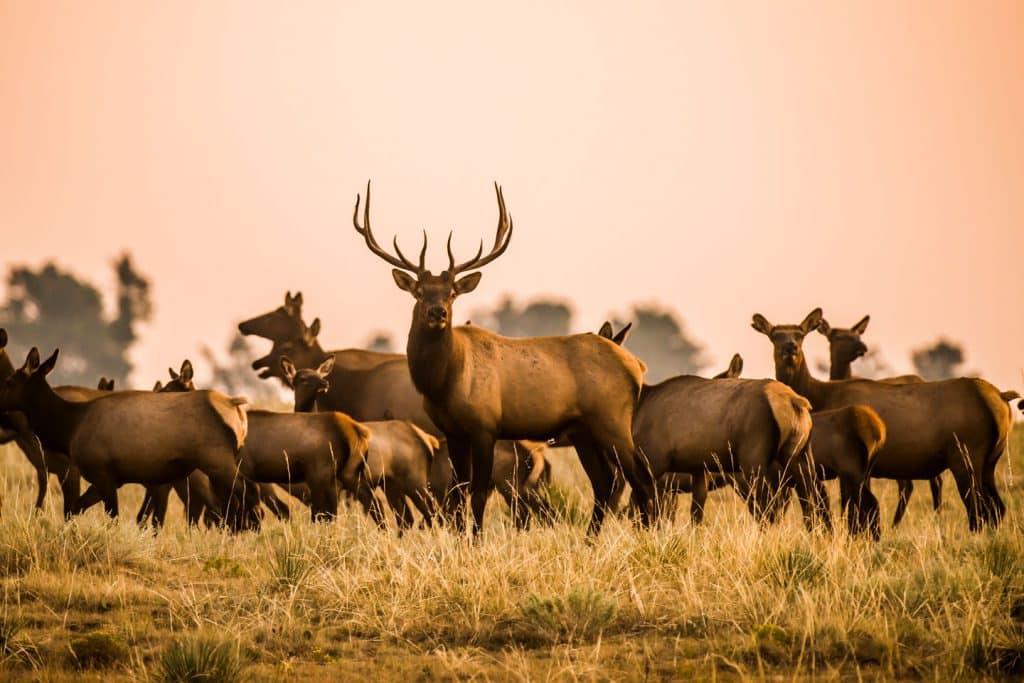
Physical description
Elk are large, majestic mammals in the Cervidae (deer) family. Adult males, or bulls, stand about 4.5 to 5 feet at the shoulder and weigh between 700 to 1,100 pounds. Females, or cows, are smaller, standing 4 to 4.5 feet at the shoulder and weighing 500 to 600 pounds. Elk have a reddish brown coat in summer that turns light brown or grayish in winter, with a distinctive cream-colored rump patch and a short tail. Bulls are notable for their large antlers, which can span up to 4 feet across and are shed and regrown annually.
Habitat
Elk inhabit a diverse range of habitats across North America, including forests, woodlands, meadows and grasslands. They are adaptable animals and can be found in various ecosystems, from mountainous regions to low-lying plains. Key features of their preferred habitats include large amounts of vegetation for foraging, access to water sources for drinking, and dense cover for protection from predators. During different seasons, they may migrate between higher elevations in the summer and lower valleys in the winter to find suitable forage and shelter.
Diet
Elk are herbivores with a diverse diet consisting primarily of grasses, forbs, shrubs and tree leaves. They are selective browsers, feeding on a wide variety of plant species depending on availability and season. In summer, they graze on tender grasses and herbaceous plants, while in winter, they resort to browsing on woody shrubs and tree bark. Their digestive system is adapted to efficiently process fibrous vegetation, allowing them to extract nutrients from a wide range of plant materials.
Population status & range
Common, found mostly in the Pine Ridge area in northwestern Nebraska.
Behavior
Elk exhibit complex social behavior, with both solitary and social tendencies depending on the season. During the mating season, known as the rut, dominant bulls compete for mates through vocal displays and physical contests. Outside of the rut, elk often form loose herds, particularly in winter, for protection against predators and to facilitate foraging. They are crepuscular, meaning they are most active during dawn and dusk. Their keen senses of sight, smell, and hearing help them detect potential threats. Elk are also known for their migratory behavior, moving between different elevations in search of food and suitable habitats throughout the year.
Fun facts
>> Elk are also called wapiti, a Native American word that means “light- colored deer”.
>> A set of antlers on a large bull elk can weigh up to 40 pounds.
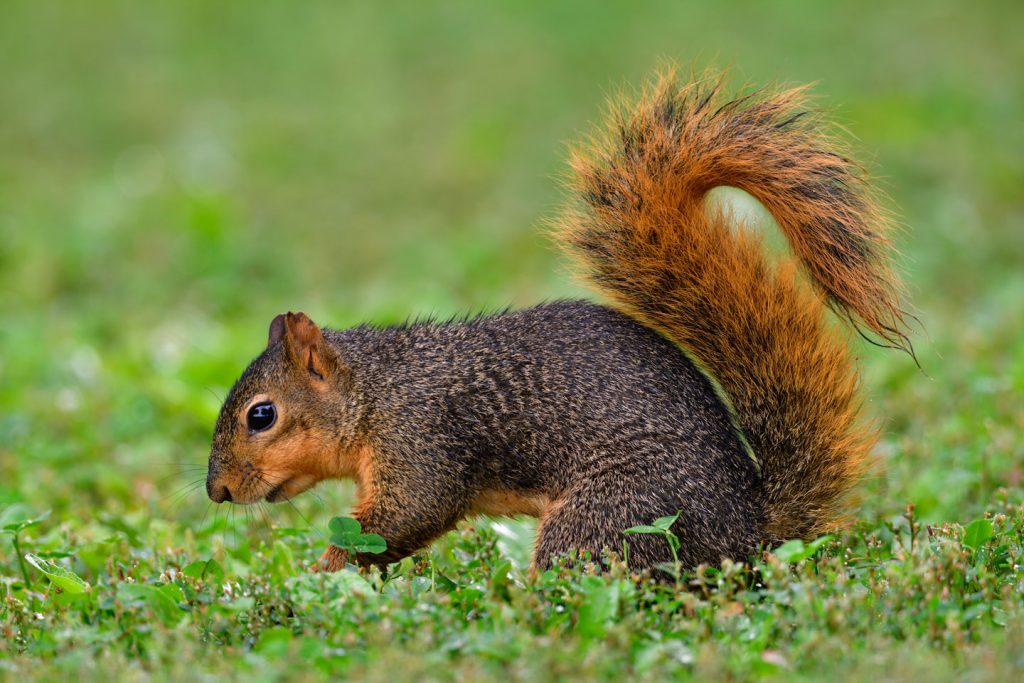
Physical description
The fox squirrel is the largest species of tree squirrel native to North America. It has a large body with a length of 18 to 29 inches, including its bushy tail which accounts for about half of its total length. Fox squirrels typically weigh between 1.5 to 2.5 pounds. Their fur is a mixture of brown and black colorations, often with a rusty or orangish underside, and they have distinctive pale or white facial markings. Their bushy tails, which are edged in dark brown or black, help them balance while navigating through trees.
Habitat
In Nebraska, fox squirrels primarily inhabit deciduous forests and wooded areas, often found along river valleys, wooded bluffs and urban parks. They prefer habitats with a mixture of large, mature trees that produce ample supplies of nuts and seeds, such as oak, hickory and walnut. Fox squirrels are also adaptable and can thrive in fragmented landscapes and suburban areas where there is a presence of scattered trees and human-provided food sources. These adaptable creatures make use of tree cavities or construct leaf nests, known as dreys, in the branches to shelter from predators and harsh weather.
Diet
Fox squirrels are omnivorous creatures with a diverse diet. Their primary food sources include nuts such as acorns, hickory nuts and walnuts, which they gather and store for consumption during winter months. They also consume a variety of seeds, fruits, berries and fungi. Additionally, fox squirrels will opportunistically feed on bird eggs, insects and even small vertebrates when available. Their adaptable diet allows them to thrive in various habitats and seasons throughout the year.
Population status & range
Common: nearly statewide
Behavior
Fox squirrels are diurnal creatures, meaning they are active during the day, and they exhibit both solitary and social behaviors. While foraging, they are often seen bounding between trees or scampering across the ground in search of food. They are territorial animals and will vigorously defend their home ranges, especially during the breeding season. Communication among fox squirrels includes a variety of vocalizations and body language, such as tail flicking and ear movements, to convey messages and warnings to other squirrels. When food is plentiful, they may hoard it in caches scattered throughout their territory to sustain them during leaner times.
Fun facts
>> Fox squirrels, like other rodents, have front teeth that never stop growing. They constantly chew and gnaw to keep them short.
>> When threatened, fox squirrels will run away in a zigzag pattern. This useful strategy allows them to escape hawks and other predators.
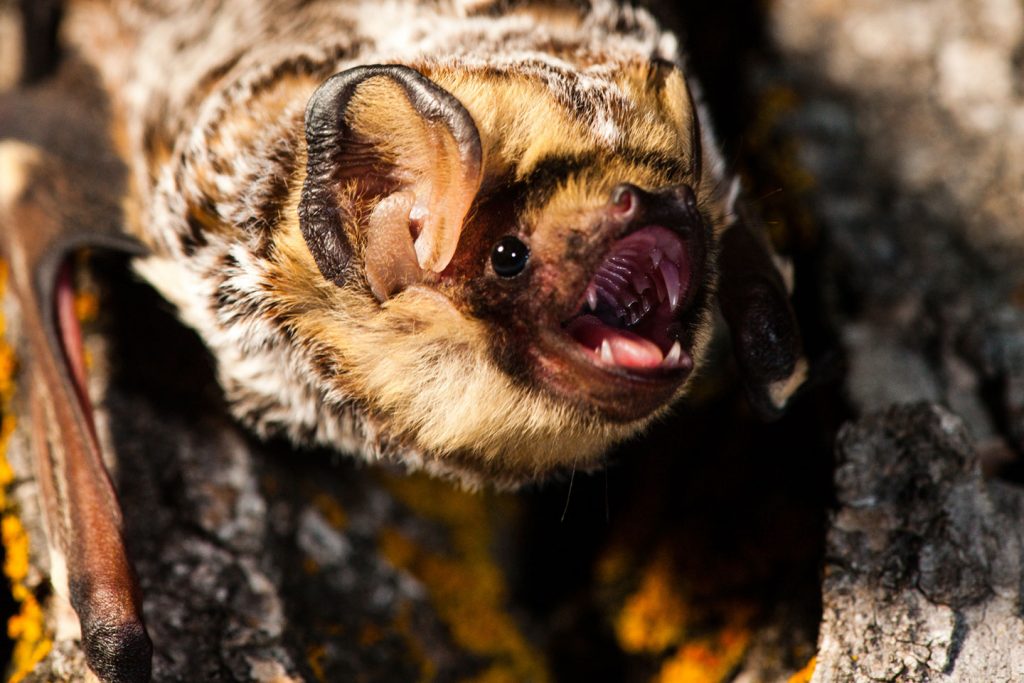
Physical description
The hoary bat is a strikingly beautiful bat species with unique physical characteristics. It has long, fluffy fur that varies in color from dark brown to silver-gray, giving it a frosted or “hoary” appearance. This fur extends to its wings, which are broad and elongated, enabling it to be an efficient flyer. The hoary bat’s ears are relatively short compared to other bat species, and it has large eyes with golden-yellow irises.
Habitat
In Nebraska, hoary bats primarily inhabit a variety of forested habitats, including deciduous and pine woodlands. They are often found roosting in trees, where they seek shelter during the day. Hoary bats may also utilize other habitats such as riparian areas, wooded corridors, usually associated with a water source in arid landscapes. Their habitat preference may vary depending on factors such as food availability, roosting opportunities, and seasonal changes.
Diet
The hoary bat primarily feeds on flying insects, making it an insectivorous predator. Its diet consists of a variety of insects, including moths, beetles, flies, and mosquitoes, which it catches in mid-air using its echolocation abilities. Hoary bats are known to forage in open spaces such as forest clearings, fields, and along water bodies where insect abundance is high.
Population status & range
Found statewide; declining species
Behavior
Hoary bats are nocturnal creatures, meaning they are most active during the night. They are agile and swift flyers, capable of covering long distances in search of prey. Using echolocation, they emit high-frequency sounds that bounce off objects and prey, allowing them to navigate and locate food in the darkness. Hoary bats are solitary animals and typically roost alone during the day, often in trees or dense foliage. They may also utilize human-made structures such as barns or buildings for roosting. During the winter months, hoary bats may migrate to warmer regions to escape harsh weather conditions.
Fun facts
>> These bats will hang out in the leaves of trees and use their furry tail membrane to wrap themselves up like their own little personal sleeping bag.
>> These bats are highly susceptible to mortality from strikes with turbines at wind farms.
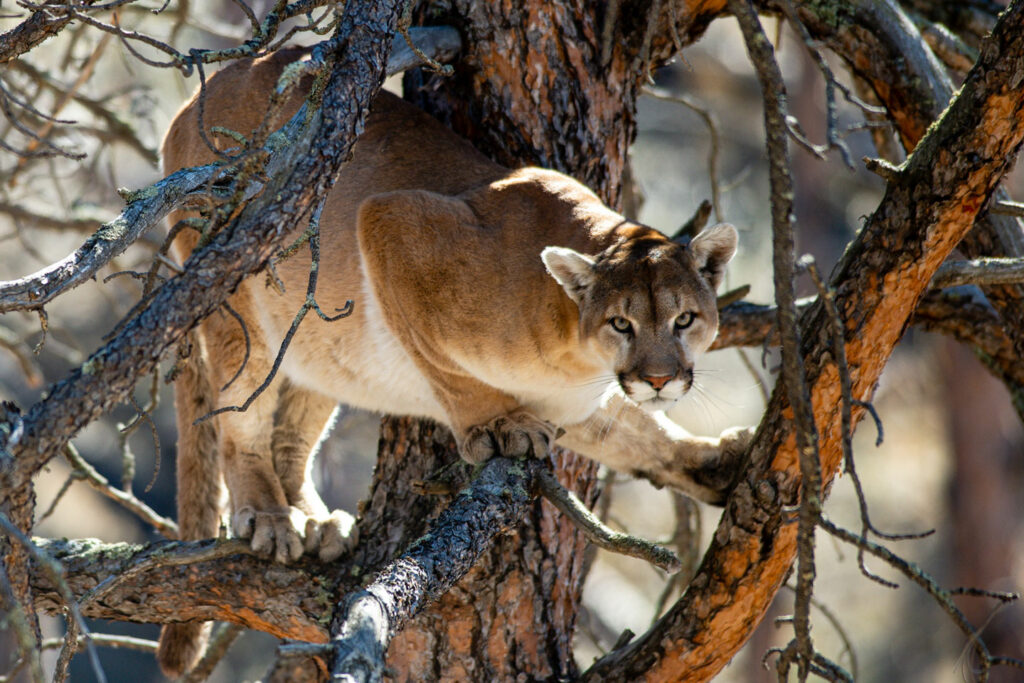
Physical description
Mountain lions, also known as cougars or pumas, are large, muscular cats with tawny-colored fur, which provides excellent camouflage in their habitats. They have short fur on their bodies and longer fur around their faces, giving them a distinctive appearance. Mountain lions have powerful limbs, enabling them to leap great distances and climb steep terrain with ease. Their rounded heads feature short, rounded ears and a long, tapered tail, aiding in balance and agility during hunting and maneuvering through their environment.
Habitat
There are three areas of suitable habitat in the state this includes the Pine Ridge, the Niobrara River Valley and Wildcat Hills. In Nebraska, mountain lions inhabit a variety of habitats, including rugged, forested areas, canyons, and grasslands. They prefer habitats with dense vegetation and rugged terrain that provide ample cover for stalking prey and hiding from potential threats. Mountain lions are also known to traverse agricultural lands and riparian corridors, especially during dispersal or in search of prey.
Diet
Mountain lions are apex predators with a diet primarily consisting of large mammals such as deer, elk, and bighorn sheep. They are opportunistic hunters and will also prey on smaller animals like raccoons, rabbits, and rodents when larger prey is scarce. Mountain lions are ambush predators, relying on stealth and surprise to catch their prey. They typically target the neck or throat of their prey, using their powerful jaws and sharp teeth to deliver a fatal bite. After making a kill, they may drag the carcass to a secluded area to consume it, often caching leftovers for later consumption.
Population status & range
Mountain lions are native to Nebraska but were eliminated by the 1890s. The first modern confirmation was made in 1991. Mountain lions were protected as game animals by statute in 1995 and statutes to allow hunting were created in 2012. There are presently breeding populations, or at least one instance of reproduction in four areas: the Pine Ridge, Niobrara River Valley, Wildcat Hills, and Northeastern Missouri River Bluffs.
Behavior
Mountain lions are solitary and elusive creatures, typically avoiding human contact and preferring to hunt and roam alone. They are primarily nocturnal but may be active during the day, especially in areas with less human disturbance. Mountain lions are highly territorial animals, marking their territories with scrapes, feces, and scent markings to communicate with other individuals. They are skilled stalkers and ambush predators, using their agility, speed, and powerful jaws to take down prey. After making a kill, mountain lions may drag their prey to a secluded location to feed undisturbed.
Fun facts
>> Their powerful hind legs enable them to jump as far as 40-45 feet in distance and as high as 15 feet vertically.
>> Mountain lions are the largest cats that purr.
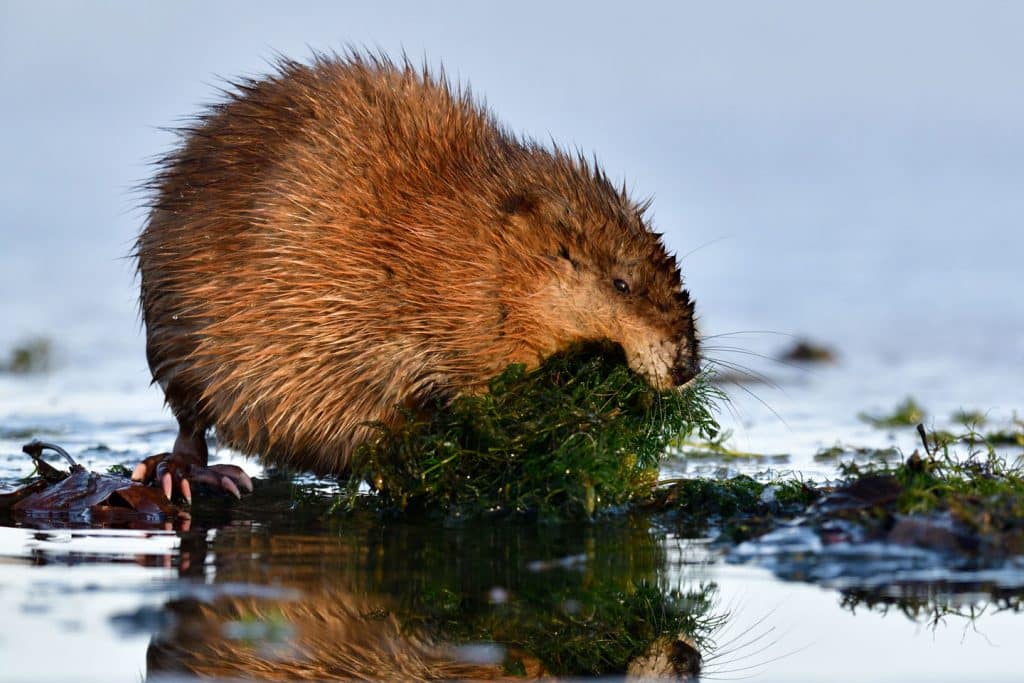
Physical description
Muskrats are medium-sized rodents with stout bodies and short legs adapted for aquatic life. They typically have dark brown fur, sometimes with lighter underparts, providing camouflage in their marshland habitats. Their most distinctive features include a sparsely haired, scaly tail, which they use as a rudder while swimming, and partially webbed hind feet for efficient movement in water. Muskrats have small ears and eyes, well-suited for their semi-aquatic lifestyle, and their snouts are rounded and blunt, facilitating their feeding behavior.
Habitat
In Nebraska, muskrats are commonly found in wetland habitats such as marshes, swamps, ponds, and slow-moving streams or rivers. They are particularly abundant in areas with aquatic vegetation, which they use for food and building their lodges. These semi-aquatic rodents thrive in environments with a mix of open water and vegetation, making wetlands across Nebraska ideal habitats for their survival.
Diet
Muskrats are herbivorous rodents with a diet primarily consisting of aquatic vegetation. They feed on a variety of plants such as cattails, sedges, grasses, and water lilies, which they harvest near the water’s edge or dive underwater to reach. Additionally, muskrats may eat roots, tubers, and agricultural crops when available. Their specialized digestive systems allow them to efficiently extract nutrients from plant material, making them well-adapted to wetland habitats.
Population status & range
Common: can be found throughout the state where there is water
Behavior
Muskrats are also known for their industrious behaviors. They are excellent swimmers and spend much of their time in water, where they forage for food and construct their lodges. Muskrats are skilled at building elaborate structures using vegetation, mud, and other available materials, creating dome-shaped lodges or burrows with underwater entrances for protection from predators. They are primarily crepuscular, meaning they are most active during dawn and dusk, although they may also be active at night. Muskrats are generally solitary animals, except during the breeding season, and communicate with each other through a variety of vocalizations and scent markings.
Fun facts
>> Baby muskrats are called kits and around 30 days old can swim, dive and feed themselves.
>> Muskrats can hold their breath underwater for around 12-17 minutes.
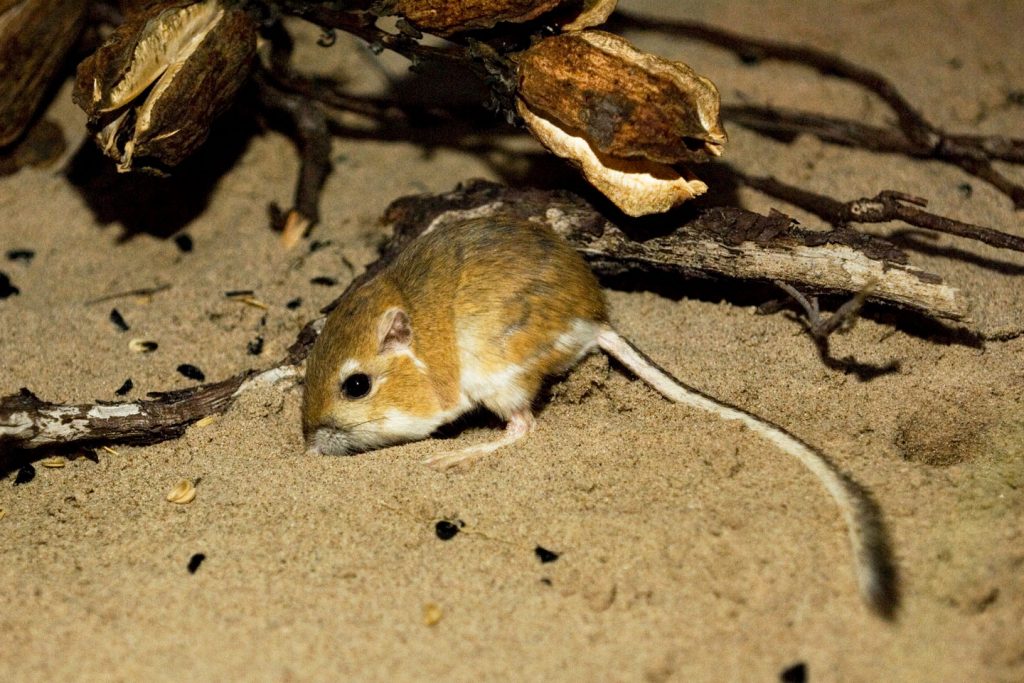
Physical description
The Ord’s kangaroo rat is a small rodent native to North America. This small creature is covered in sandy, light brown fur that serves as camouflage in its Sandhills habitat. One of its most notable features is its long, tufted tail, longer than its body, used for balance and propulsion during its characteristic hopping movements. With large, rounded ears and powerful hind legs adapted for jumping, this species navigates the arid terrain with agility and efficiency.
Habitat
The Ord’s kangaroo rat is found in 17 states, including western Nebraska. Their habitat preferences usually include arid climates with sparse vegetation covering sandy ground. Studies have shown that with an increase in ground cover, like vegetation, the population in the area will actually decrease. So, in Nebraska, there really is no better location than the western one-third of the state for kangaroo rats to live — more specifically the Sandhills.
Kangaroo rats are also one of few animals capable of establishing burrows in shifting sands. During the day, these animals protect their burrows by using their back legs to pack sand at the entrance. This not only ensures predators cannot get in while they are sleeping, but also helps keep out heat during the dog days of summer.
Diet
The diet of Ord’s kangaroo rats is primarily composed of seeds. To carry all these seeds, these rodents have special fur-lined cheek pouches to transport food back to their burrows for storage. In the summer, they may also feed on grasshoppers and moths.
Because these animals are mostly found in the arid or semi-arid areas of the United States, they are very effective at water retention. Kangaroos rats receive most of the moisture they need from plants that they eat, and they do not sweat or pant like other animals when they need to keep cool. Also, these rodents are equipped with a unique metabolism and specialized kidneys that allow them to survive without drinking water. As a result, they have very little need for water consumption and could technically go their whole lives without drinking water. They only drink water when absolutely necessary.
Population status & range
Western 2/3 of the state, primarily south of the Platte River.
Behavior
Kangaroo rats are nocturnal. If you look closely, you will see large black eyes, which allow them to see at night, unlike diurnal, or daytime, animals. In addition to amazing night vision, kangaroo rats also have a keen sense of smell and extraordinary hearing.
For identification, individuals have a special oil-secreting gland that is located between their shoulders. Secretions from this gland help kangaroo rats distinguish individuals and sexes when they encounter each other’s scent in the wild. To keep their fur from becoming oily and matted, kangaroo rats will regularly bathe in sand.
Fun facts
>> Much like Australian kangaroos, these rodents can jump! If disturbed by a predator, such as a rattlesnake, these animals are like spring-loaded ninjas. They can jump up to 9 feet in the air and if needed, have the ability to switch directions mid-jump.
>> Kangaroo rats have kidneys that concentrate their urine to a crystal-like consistency, so they lose very little water through waste. They excrete only tiny droplets of hyper-concentrated urine very occasionally, so they don’t really pee.
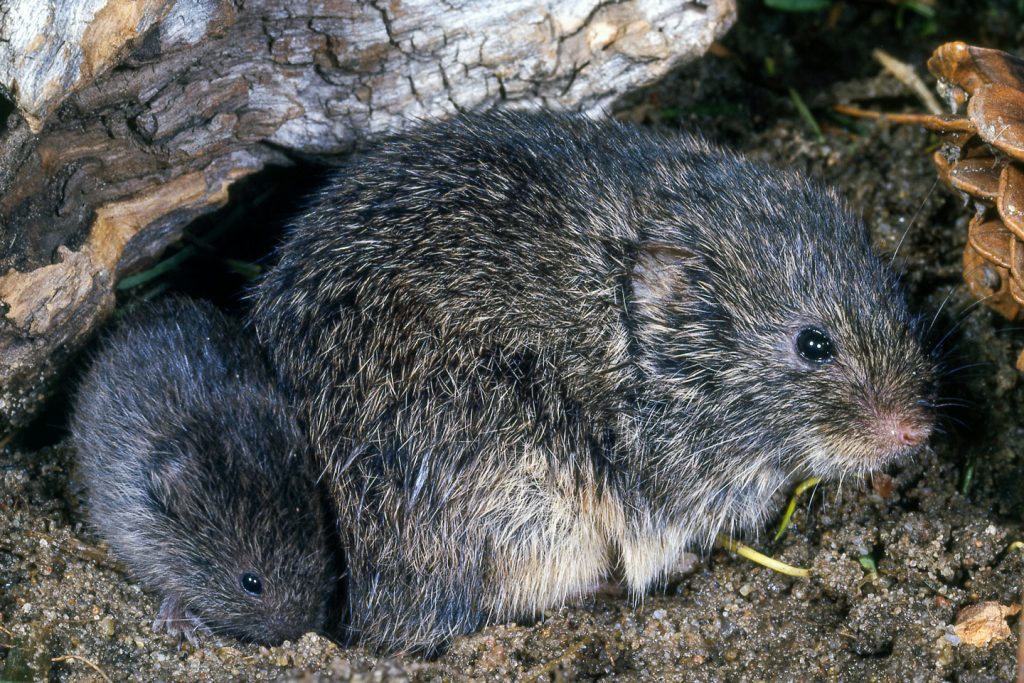
Physical description
Prairie voles are small rodents with a compact, cylindrical body structure. They typically measure around 4 to 5 inches in length, excluding their short tail which adds another 1 to 2 inches. Prairie voles have soft, dense fur that can vary in color from brown to grayish brown, with lighter underparts. They have small, rounded ears and relatively large eyes. One distinctive feature of prairie voles is their short, furry tail that is often concealed within their coat.
Habitat
In Nebraska, prairie voles inhabit a variety of grassland habitats, including tallgrass and mixed-grass prairies, as well as meadows and fields with dense vegetation. They are particularly common in areas with moist, well-drained soils, such as along stream banks, wetlands and marshy areas. Prairie voles construct intricate burrow systems underground, which serve as shelter from predators and harsh weather, as well as for nesting and raising their young. These rodents are well-adapted to the open landscapes of Nebraska, where they forage for grasses, seeds and other vegetation, playing important roles in ecosystem dynamics and nutrient cycling.
Diet
Prairie voles have a primarily herbivorous diet, consisting mainly of grasses, seeds and other plant material. They feed on a variety of grasses and herbs found in their grassland habitats, as well as seeds from various plant species. Prairie voles may also consume roots, bulbs and other underground parts of plants. Occasionally, they may supplement their diet with insects or other small invertebrates.
Population status & range
Common in the western 2/3 of Nebraska
Behavior
Prairie voles are highly social rodents known for their monogamous mating system and complex social behaviors. They form long-term pair bonds and engage in extensive social interactions, including grooming, huddling, and mutual grooming. These rodents are also territorial, defending their home ranges from intruders of the same species. Prairie voles construct intricate burrow systems underground, where they raise their offspring and seek shelter from predators.
Fun facts
>> Prairie voles can mate year-round, but it is more frequent in spring and fall.
>> Life expectancy for the prairie vole is around one to two months, but in captivity they could surpass 16 months.
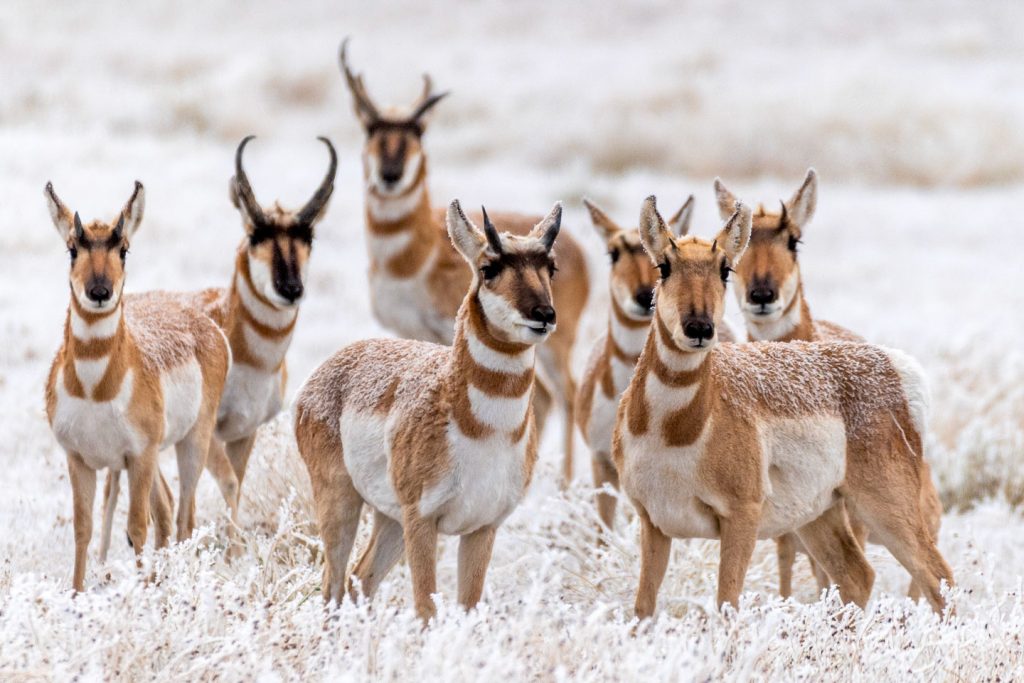
Physical description
The pronghorn, often referred to as the American antelope, is a unique North American ungulate (hooved animal) characterized by its slender build and distinctive horns. It has a reddish-brown coat with white underparts and a conspicuous white rump patch. Both males and females have horns, though the males’ are larger and feature a prominent prong. Its long, slender legs contribute to its remarkable speed and endurance, making it one of the fastest land animals in North America.
Habitat
In Nebraska, pronghorns primarily inhabit the open plains and grasslands, favoring areas with a mix of short grasses and sagebrush. These regions provide the necessary resources for grazing and offer expansive visibility to detect predators. Pronghorns are well adapted to the semi-arid environment of Nebraska’s Sandhills and the western part of the state, where they can find the sparse vegetation and rugged terrain they prefer. Their habitat selection is influenced by the availability of food and water sources, as well as the need for space to roam and evade predators.
Diet
The pronghorn’s diet consist of a variety of vegetation. During the summer months, pronghorns favor forbs and shrubs, which are rich in nutrients and moisture. In the winter, when green vegetation is scarce, they rely more on dry grasses and sagebrush. Pronghorns have a highly efficient digestive system that allows them to extract nutrients from tough, fibrous plants, enabling them to thrive in the harsh, arid environments they often inhabit.
Population status & range
Common: found in the western part of the state in the Sandhills ecoregion, and Nebraska Panhandle
Behavior
Pronghorns are known for their remarkable speed and agility, capable of running at speeds up to 55 miles per hour, which they use to evade predators. They are social animals, typically forming small herds that can number in the hundreds during migration or in the winter. Pronghorns exhibit keen eyesight, with their large eyes providing a wide field of vision to spot danger from a distance. They communicate through a variety of vocalizations and physical displays, such as raising the white hairs on their rump to signal alarm. Despite their speed, pronghorns prefer to flee rather than fight, relying on their endurance and keen senses for survival.
Fun facts
>> Pronghorns are the sole surviving members of the Antilocapridae family.
>> They have the largest eyes of any North American ungulate in relation to body size, with eyeballs around 1.4 inches in diameter.
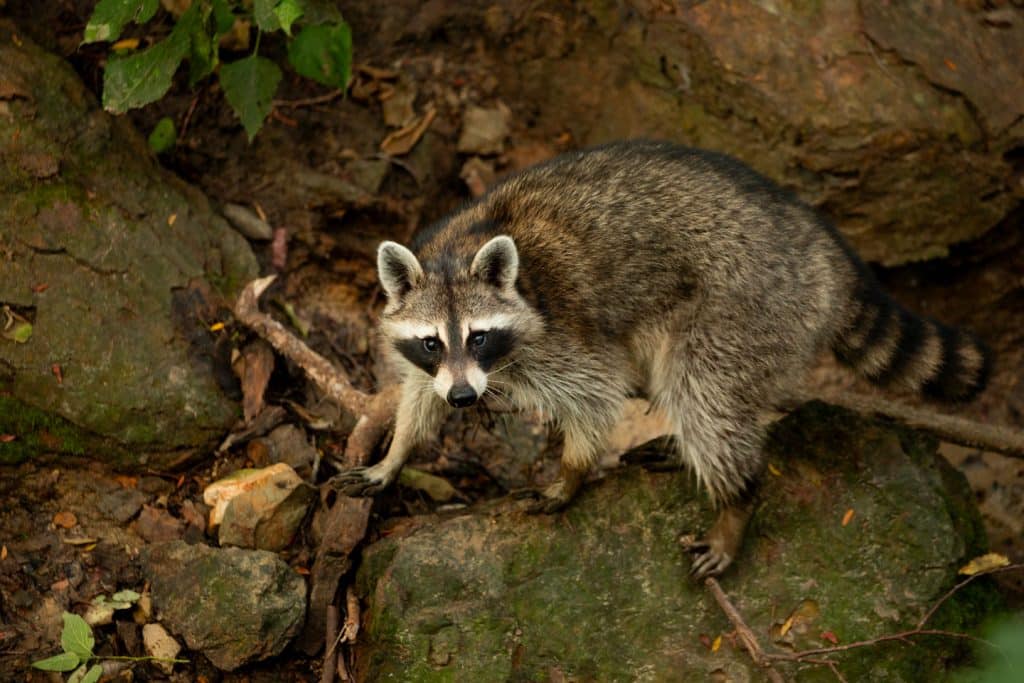
Physical description
Raccoons are easily recognizable for their distinctive appearance. These medium-sized mammals have a stocky build with a dense, grayish-brown fur coat marked by black “mask” patterns around their eyes, giving them a bandit-like appearance. Their bushy ringed tails and dexterous front paws equipped with long, agile fingers contribute to their characteristic look. Raccoons typically have a pointed snout and rounded ears, completing their iconic appearance.
Habitat
In Nebraska, raccoons inhabit a variety of habitats, including forests, woodlands, riparian areas, and suburban neighborhoods. They are highly adaptable creatures and can thrive in diverse environments. Raccoons seek out den sites in hollow trees, abandoned burrows, rock crevices, and even human-made structures like attics, chimneys, and sheds. They are also commonly found near water sources such as streams, rivers, and ponds, as they are skilled foragers and enjoy aquatic prey like fish and amphibians.
Diet
Raccoons are opportunistic omnivores with a diverse diet. Their adaptable nature allows them to consume a wide range of foods, including fruits, berries, nuts, insects, small mammals, birds, eggs, and amphibians. They are also known to scavenge for human food scraps, raid garbage bins, and even forage in gardens. Raccoons’ dexterous front paws enable them to manipulate objects and open containers, making them highly effective at accessing various food sources in their environment.
Population status & range
Common: can be found statewide
Behavior
Raccoons are primarily nocturnal creatures, although they can also be seen foraging during the day — especially in areas with abundant food sources. Highly adaptable and curious, raccoons are skilled climbers and swimmers. They utilize these abilities to explore and access food. Raccoons are solitary animals, except during mating season or when females are raising their young. They’re well-known for their cleverness and problem-solving skills, using their nimble hands to manipulate objects and open containers. Despite their generally solitary nature, they may congregate in areas with plentiful food or den sites.
Fun facts
>> Raccoons can make over 50 different vocal noises.
>> These mammals can run as speeds as fast as 15 mph, not only on solid ground, but also while climbing up and down trees.
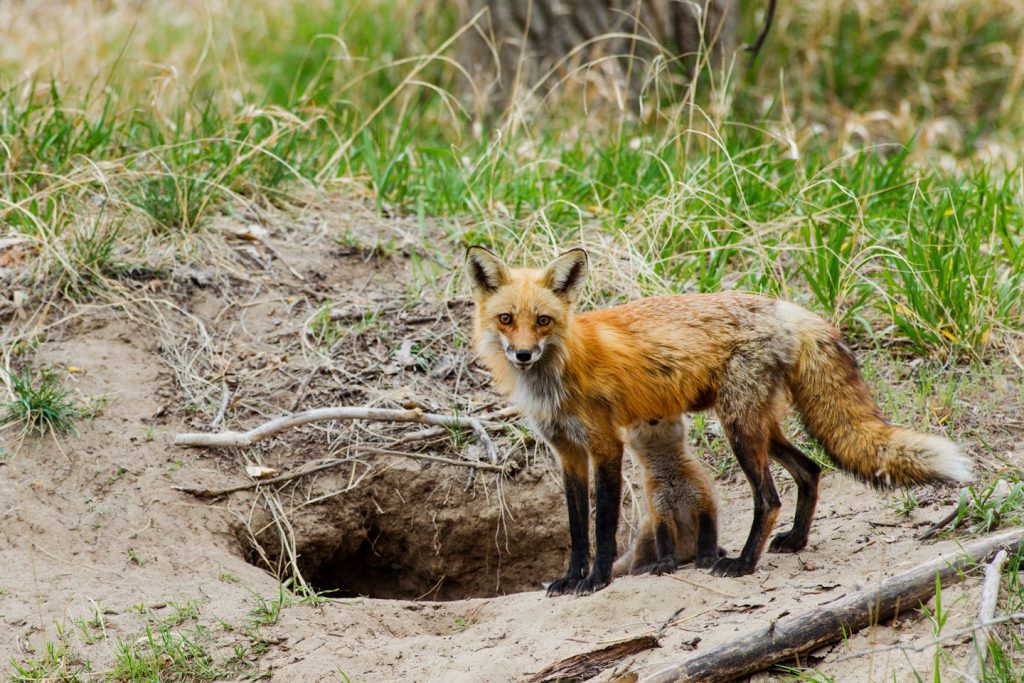
Physical description
The red fox is a medium-sized carnivore known for its striking appearance. It has a slender body covered in thick, reddish-orange fur on its back and sides, with a white underside. The fox’s long, bushy tail, known as a “brush,” often features a white tip, and its pointed ears are characteristic of the species. Red foxes have keen, almond-shaped eyes, typically amber or yellow in color, and their legs are relatively short but powerful, aiding in their agility and speed.
Habitat
Red foxes are highly adaptable animals found in a diverse range of habitats worldwide, including forests, grasslands, deserts, and urban areas. They prefer habitats with a mix of open spaces for hunting and dense vegetation for cover and denning sites. Red foxes are opportunistic and will exploit various food sources, adapting their habitat use accordingly. They are commonly seen near human habitation, where they can find food and shelter.
Diet
Red foxes are omnivorous predators with a varied diet. Their primary food sources include small mammals such as rodents, rabbits, and voles, as well as birds, insects, and reptiles. They are also known to scavenge for carrion and feed on fruits, berries, and other vegetation when available. Their adaptable diet allows them to thrive in a variety of habitats, from forests to urban areas, where they can exploit a wide range of food sources.
Population status & range
Common: found statewide
Behavior
Red foxes are highly adaptable and intelligent animals, known for their cunning behavior. They are primarily nocturnal and crepuscular, hunting and foraging during the night and at dawn or dusk. Red foxes are solitary hunters, but they may form pairs during the breeding season. They are skilled predators, using stealth and agility to stalk and ambush their prey. Additionally, red foxes are known for their playful behavior, engaging in activities such as pouncing, chasing, and mock fighting, which may help them hone their hunting skills.
Fun facts
>> Red foxes have supersonic hearing and can even hear rodents digging miles underground.
>> When afraid red foxes like grin. It is a sign of submission along with arching their backs and bringing themselves lower to the ground while laying their ears back.
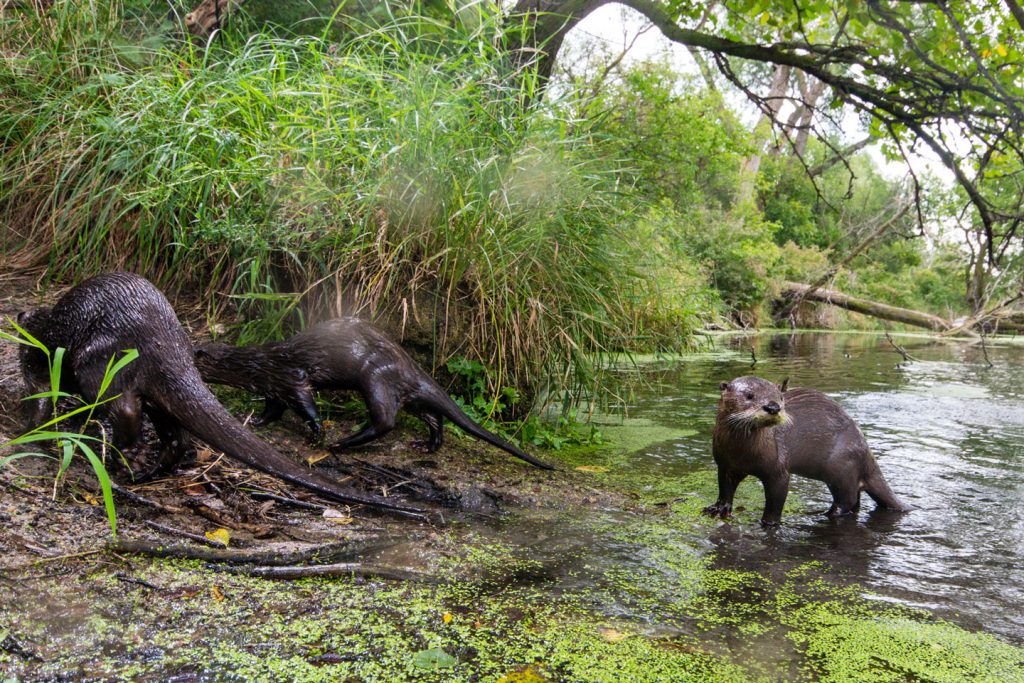
Physical description
North American river otters are sleek, semi-aquatic mammals with a streamlined body adapted for life in water. They have dense, water-repellent fur that ranges in color from dark brown to reddish-brown on their back, fading to a lighter shade on their underside. Their long, muscular tail serves as a rudder while swimming. River otters have webbed feet and agile paws equipped with sharp claws, enabling them to efficiently catch prey and manipulate objects. They possess a broad, flattened head with small ears and a prominent snout, equipped with sensitive whiskers that aid in detecting prey underwater.
Habitat
River otters are found along streams and rivers that flow through Nebraska’s tallgrass, mixed grass and shortgrass prairies. They also are found in the Sandhills around streams, lakes, ponds, marshes and swamps. They may den in hollow logs, underground space among roots, overhangs, beaver lodges or dens and other animal burrows. They often have a large home range to ensure they have enough food and resources.
Diet
River otters are opportunistic and will eat foods that are most available. Fish make up the greatest portion of the otter’s diet; followed by crayfish. Other foods include amphibians, insects, small mammals and birds. In clear water, river otters use their excellent swimming ability to capture fish by sight and direct pursuit. In murky water, they use their whiskers to locate prey by movement.
Population status & range
Thanks to conservation efforts, river otter populations in Nebraska are growing. In January 2020, the Nebraska Game and Parks Commissioners voted to remove river otters from the state threatened list based on recommendations from the staff biologists. They presently have a nearly statewide distribution, and their population is secure.
Behavior
River otters communicate using several methods. Vocalizations include chirping, growling, whistles, and screams. They also communicate through scent marking using a pair of scent glands located at the base of their tail. They also scent mark by urinating or defecating at latrine areas throughout their home range. And finally, they communicate through body language, including touch and posture. Anyone fortunate enough to observe an otter in the wild will not likely forget its playful, inquisitive nature or its graceful swimming ability. River otters tend to be active at night, although in undisturbed areas they may be active during the day. Several Nebraska species look like the northern river otter, including mink and beaver.
Fun facts
>> River otters can hold their breath for up to 8 minutes while underwater.
>> They slide! In the winter and even the summer you may find river otter “slides”. This is a fast and efficient ways for otters to get around.

Physical description
The striped skunk is characterized by its distinctive black fur with white stripes running down its back, contrasting with its white underbelly. Its body is stout and low to the ground, with short legs and a bushy tail. The skunk’s most notable feature is its scent glands located near the base of its tail, which it can spray as a defense mechanism when threatened. This nocturnal mammal typically has a white spot or stripe on its forehead, and its small, pointed ears add to its alert appearance.
Habitat
Striped skunks inhabit a variety of habitats in Nebraska, including grasslands, forests, woodlands, and agricultural areas. They are very adaptable and can be found in both rural and suburban environments. Skunks typically seek out den sites in underground burrows, hollow logs, brush piles, or human-made structures like sheds and crawl spaces. They prefer areas with ample food sources, making farmlands and suburban neighborhoods attractive habitats.
Diet
Striped skunks are omnivores with a varied diet. Their meals consist of insects like beetles, grasshoppers, and larvae, which they forage for in the soil and leaf litter. Additionally, they consume small mammals, birds, eggs, fruits, berries, and vegetation, making them opportunistic feeders. Skunks are also known to scavenge for human food scraps and raid garbage bins, showcasing their adaptability to various food sources within their habitat.
Population status & range
Common: can be found statewide
Behavior
Striped skunks are nocturnal animals, primarily active during the night. They are generally solitary creatures, except during the breeding season. Skunks are known for their distinctive defense mechanism – they can emit a foul-smelling spray from their scent glands when threatened. Despite this, they are not aggressive by nature and typically give warning signs, such as stomping their feet or raising their tail, before resorting to spraying. Skunks are skilled diggers, excavating burrows or dens for shelter and raising their young. They have a keen sense of smell and are opportunistic feeders, foraging for a variety of food items in their habitat.
Fun facts
>> Skunks can accurately spray up to 10 feet away, often several times in a short period before needed to recharge their scent glands.
>> Great horned owls are one of the main predators of skunks. They can swoop silently from above and also have a very weak sense of smell.
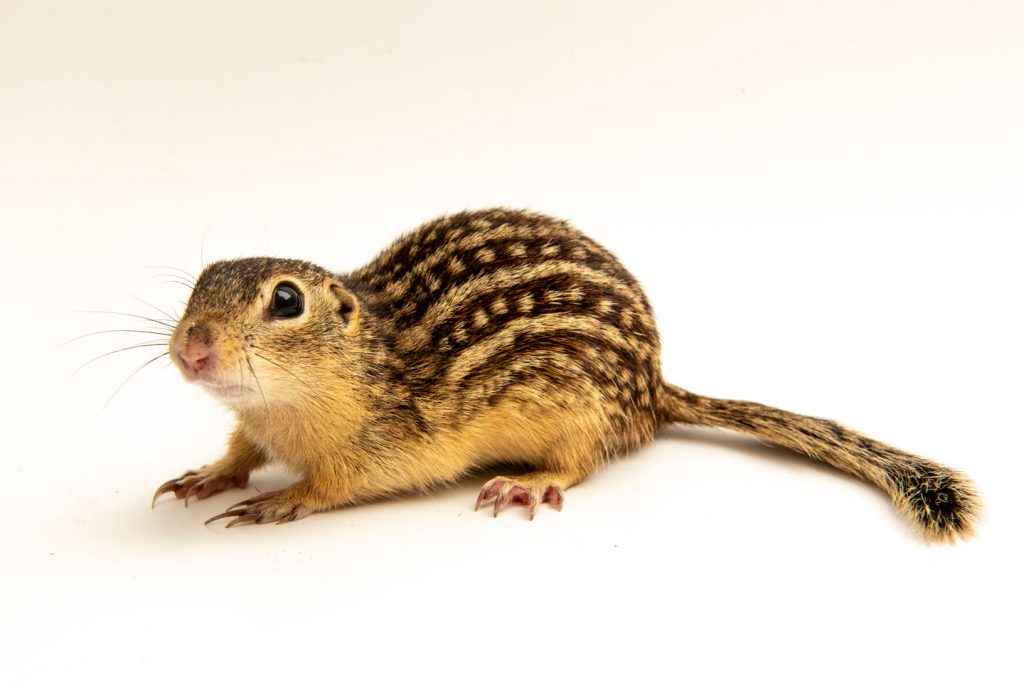
Physical description
Thirteen-lined ground squirrels are small rodents with distinctive stripes. They typically measure around 7 to 10 inches in length, including their short, furry tails. Their fur is characterized by thirteen alternating dark and light stripes running along their back and sides, giving them their name. The stripes extend from their head to the base of their tail, with the lighter stripes often bordered by darker markings. Their underparts are usually lighter in color, ranging from white to pale yellowish. Thirteen-lined ground squirrels have small ears and sharp, curved claws suited for digging burrows. Their coloration allows them to camouflage well within their grassland home, providing them cover from predators such as hawks and foxes.
Habitat
In Nebraska, thirteen-lined ground squirrels inhabit a range of grassland habitats, including prairies, meadows and open fields. They are particularly common in areas with sandy or well-drained soils where they can dig their extensive burrow systems. These burrows provide shelter from predators and extreme weather. They also serve as hibernation sites during the winter months. Thirteen-lined ground squirrels are well-adapted to the vast expanses of grasslands in Nebraska, where they forage for seeds, grains and insects in the open spaces between vegetation.
Diet
Thirteen-lined ground squirrels are omnivorous rodents with a varied diet. They primarily feed on seeds, grains and nuts. They also consume a significant amount of insects, especially during the summer months when insect populations are abundant. Additionally, they may eat fruits, vegetation, and even carrion. This adaptable diet allows them to thrive in diverse habitats, from grasslands to agricultural fields, where they play a role in seed dispersal and pest control.
Population status & range
Common: nearly statewide
Behavior
Thirteen-lined ground squirrels are highly active diurnal rodents. They are social animals, often living in colonies with complex underground burrow systems. Thirteen-lined ground squirrels are efficient foragers, primarily feeding on seeds, grains, insects and plant matter. They frequently stand upright to scan their surroundings for potential threats while emitting alarm calls to warn colony members of danger.
Fun facts
>> Young are born in the burrow in May and June, and their eyes open about three weeks after birth. They leave the nest after about one month.
>> Hibernation occurs from November to March, with adult males starting first. The entrance to the hibernation chamber is blocked, and the animal’s body temperature drops to just above freezing. Its heart rate slows to five beats per minute, and it only breathes about four times a minute.
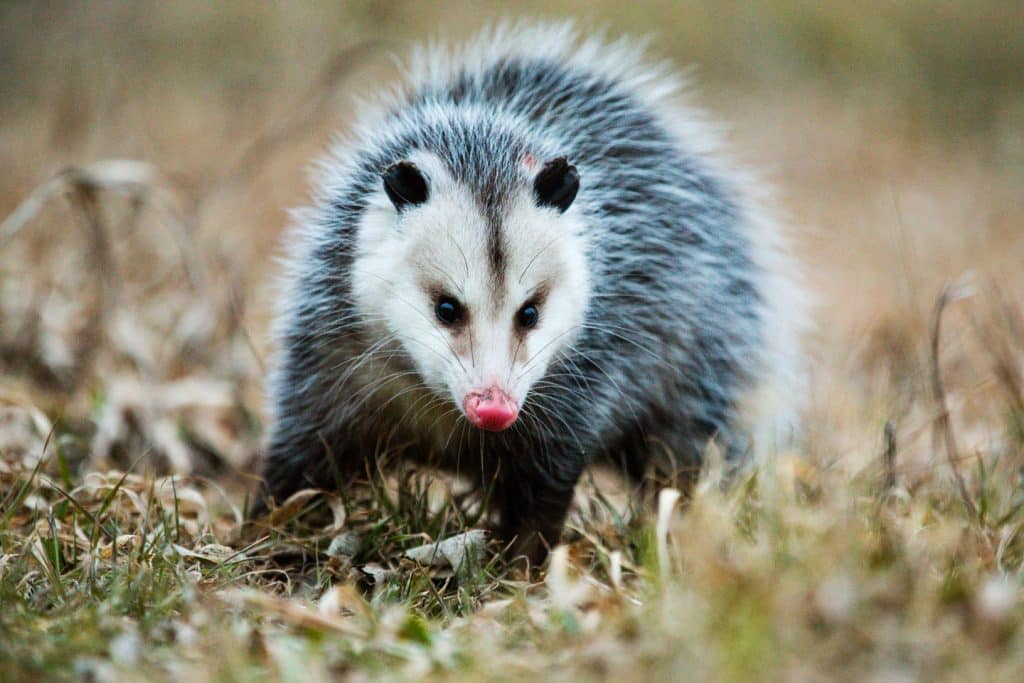
Physical description
The Virginia opossum, North America’s only marsupial, boasts a distinctive appearance. Its body is roughly the size of a house cat, covered in coarse, grizzled fur that varies in color from grayish-white to black. The opossum’s most recognizable features are its long, pointed snout, pink nose, and hairless ears and tail. Males and females look similar, although mature females will have a fur-lined belly pouch in which they carry their underdeveloped young until they are ready to venture off on their own.
Habitat
Virginia opossums are adaptable creatures found throughout a variety of habitats across Nebraska. They thrive in wooded areas, forests, and brushy habitats, but also inhabit urban and suburban environments. These marsupials are particularly versatile, making homes in dens, hollow logs, abandoned burrows, and even under buildings or decks. They are opportunistic feeders, able to adjust to different food sources, which contributes to their ability to inhabit diverse habitats.
Diet
Virginia opossums, being omnivorous, consume both plant matter and animals. Their diet comprises fruits, berries, seeds, eggs, birds, insects, and carrion. They exhibit opportunistic feeding behaviors, readily consuming a variety of items, which enhances their effectiveness as scavengers.
Population status & range
Common: found nearly everywhere in Nebraska; less common in the Sandhills ecoregion
Behavior
The Virginia opossum exhibits a nocturnal lifestyle, primarily active during the night. Despite its somewhat slow and deliberate movements, it can be quite agile and adept at climbing trees and fences, thanks to its prehensile tail. When threatened, opossums perform the famous behavior of “playing dead” or “playing possum”. Contrary to popular belief, they don’t do this on purpose — they go into shock from fear and faint involuntarily. They are then in a catatonic state until they gain consciousness.
Fun facts
>> The opossum has an average lifespan of 1-2 years.
>> Opossums have 50 teeth, more than any other North American land mammal.
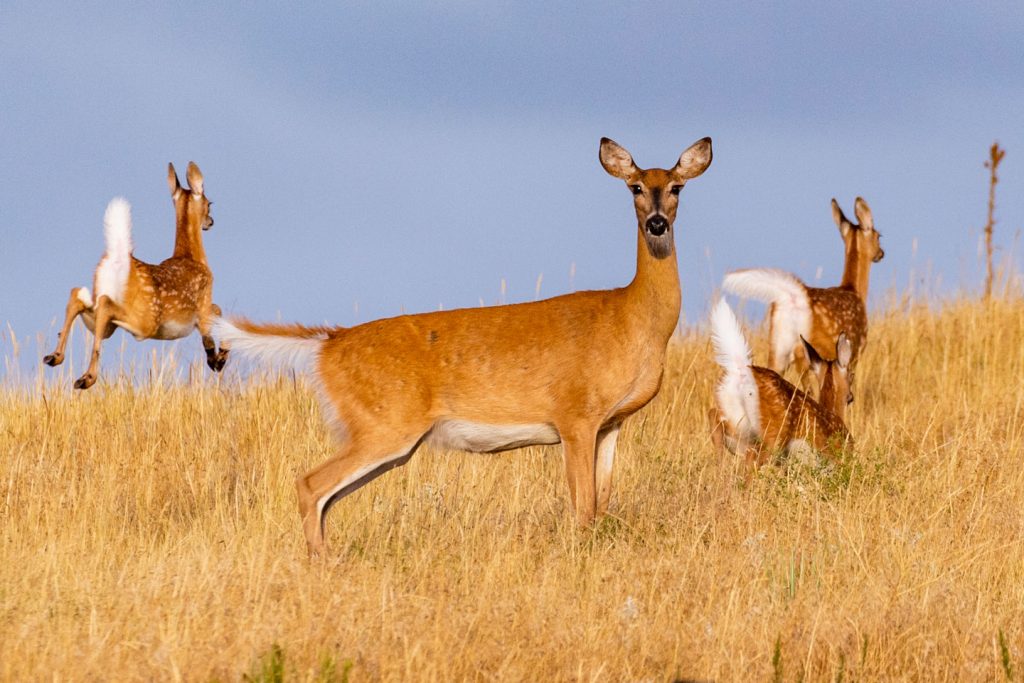
Physical description
The white-tailed deer is a medium-to-large-sized mammal with a distinctive appearance. It has a reddish-brown coat in the summer and a grayish-brown coat in the winter, with a white underside and throat patch. Its tail, which is typically held erect when alarmed, is brown on top and white underneath, with a broad white band near the tip. White-tailed deer have long, slender legs adapted for running, and their large ears are proportionate to their head size. Bucks (males) grow antlers, which are shed and regrown annually, while does (females) lack antlers.
Habitat
In Nebraska, white-tailed deer inhabit a variety of habitats, including forests, woodlands, grasslands, and agricultural areas. They prefer habitats with a mix of open spaces for grazing and dense vegetation for cover and shelter. White-tailed deer are commonly found near water sources such as rivers, streams, and ponds, as these areas provide essential drinking water and are often surrounded by suitable forage. Their habitat use may vary depending on the season, with deer moving to different areas for feeding, mating, and raising young.
Diet
White-tailed deer are herbivores with a diet primarily consisting of vegetation. They feed on a variety of plants, including grasses, forbs, leaves, twigs, and buds. During the spring and summer months, they consume a significant amount of tender shoots, leaves, and grasses. In the fall, they may shift their diet to include acorns, fruits, and nuts, taking advantage of seasonal food sources. Additionally, white-tailed deer are known to browse on agricultural crops such as soybeans, corn, and alfalfa, which can sometimes lead to conflicts with farmers.
Population status & range
Common: found statewide
Behavior
White-tailed deer are social animals that often form small family groups consisting of does and their fawns. During the mating season, or rut, bucks engage in competitive behaviors to establish dominance and mate with receptive does. These deer are vigilant and wary, using their keen senses of smell, sight, and hearing to detect potential threats. When startled or threatened, they may flee quickly, bounding away with impressive speed and agility. During the spring and summer, white-tailed deer may groom themselves by licking their fur and removing ticks and parasites. They may also engage in rubbing behavior to mark their territory and remove velvet from their antlers.
Fun facts
>> White-tailed deer are good swimmers and will use large streams and lakes to escape predators.
>> They are the smallest deer of North America. The average weight of a buck (male) is around 150 pounds while the average weight of a female (doe) is around 100 pounds.
Physical description
Woodchucks, also known as groundhogs, are sturdy rodents found throughout much of North America. They have a stout and compact body, typically measuring around 16 to 20 inches in length, not including their short, bushy tail which adds another 6 to 7 inches. Woodchucks have coarse fur that can vary in color from reddish brown to grayish brown, with lighter underparts. Their head is broad with small, rounded ears and dark eyes. Woodchucks have powerful limbs with strong claws adapted for digging burrows, their primary shelter and hibernation sites.
Habitat
In Nebraska, woodchucks typically inhabit a variety of habitats, including grasslands, fields, meadows and open woodlands. They prefer areas with abundant vegetation for food and cover, as well as well-drained soils suitable for burrowing. Woodchucks are often found along forest edges, fence lines, and roadside embankments where they can dig their burrows into the soil. These burrows provide them with shelter, protection from predators and a place to hibernate during the winter months. Woodchucks are adaptable animals and can thrive in both rural and suburban areas throughout Nebraska.
Diet
Woodchucks are herbivores with a primarily vegetarian diet. They feed on a variety of vegetation, including grasses, clover, alfalfa, dandelions, and other leafy greens. Additionally, they consume a range of agricultural crops such as corn, soybeans, and garden vegetables, making them occasional pests for farmers and gardeners. Woodchucks are known for their voracious appetite, especially during the summer months when vegetation is abundant. They spend a significant portion of their time foraging for food to sustain their energy levels and to store fat reserves for hibernation during the winter.
Population status & range
Found in the eastern 1/3 of Nebraska, but expanding westward
Behavior
Woodchucks are primarily solitary creatures, although they may share overlapping territories with others. They’re most active during the day, spending much of their time foraging for vegetation. When startled or threatened, they emit a loud whistle and quickly retreat to the safety of their burrows. Woodchucks are known for their skilled digging abilities, creating extensive burrow systems that serve as shelters, hibernation sites and nurseries for their young. Despite their shy nature, they can exhibit curious behavior, cautiously investigating their surroundings.
Fun facts
>> These rodents communicate through whistles, and are sometimes referred to as “whistle pigs”.
>> Woodchucks can dig complex underground burrow systems, often with multiple entrances. These systems can range from 2-6 feet deep and usually range between 8 and 50 feet long.


